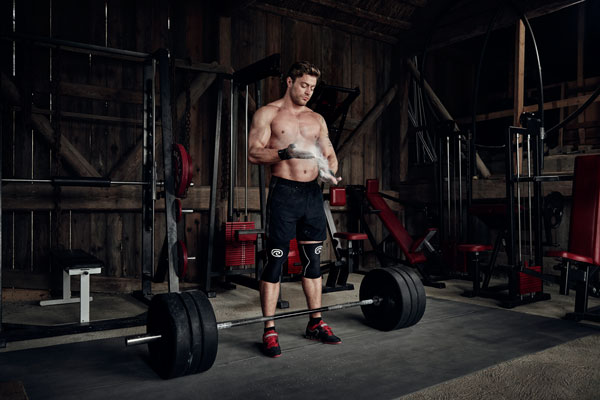Tennis Elbow
Tennis Elbow, also known as Lateral Epicondylitis in medical terms, is a pain on the outside of the elbow. The pain is due to inflammation in the tendons joining your forearm muscles to the outside of the elbow. Tennis elbow is usually caused by repetitive movements of the hand and forearm during a longer period of time. Rehband supports can help ease the pain and speed up the recovery.
TENNIS ELBOW - PAINFUL BUT TREATABLE
Tennis elbow, or lateral epicondylitis, is a chronic condition of progressive pain on the outside of the elbow and is known to be troublesome to treat. This usually occurs due to activities that require repeating wrist extension, which eventually damages the muscles and tendons in the forearm.
REPEATED MOVEMENTS AND TWISTING ARE COMMON CAUSES
Various types of racquet sports are a common cause of the condition. However, this is also a common issue among craftsmen, cooks and office employees, and there are multiple other activities that can put you in risk such as golf or any other sport that involves twisting your wrist and using the muscles in your forearms.
A TENNIS ELBOW AFFECTS THE MUSCLES AND TENDONS
Lateral epicondylitis is most common for people between the ages of 30 and 50 and it involves the muscles and tendons in the forearm that extend your wrist and fingers. The overuse of these muscles eventually creates damages that are located where the tendons in the forearm, also known as extensors, attach the muscles to the bones on the outside of the elbow, which is called the lateral epicondyle. The extensor carpi radialis brevis (ECRB) is the tendon that usually is involved when a tennis elbow occurs: through microscopic tears where the tendon attaches to the lateral epicondyle that may be caused by overuse, and the location of the muscle that causes it to rub against bony bumps, gradually wearing on the tendon over time. The ECRB muscle’s function is to stabilize the wrist when the elbow is straight.
LACK OF GRIP STRENGTH AND PAIN ARE COMMON SYMPTOMS
Some of the symptoms that may indicate that you have the condition can be: lack of grip strength and pain or burning on the outside of the elbow. The trouble is aggravated through any activity that involves your forearm, such as brushing your teeth, lifting, writing or computer work. One of the main reasons for obtaining a tennis elbow is due to the equipment that is being used. Improper techniques, smoking and obesity are also risk factors in the general population for the development of this condition.
NONSURGICAL TREATMENTS ARE USUALLY SUFFICIENT
The natural course of the tennis elbow has a recovery period of one to two years in 80-90% of cases. Even though surgical treatments for the tennis elbow have a high success rate, approximately 80-95% of patients reach a positive result with nonsurgical treatments. Some of these involve steroids injections and anti-inflammatory medicines, although studies have shown that most cases are improved in the long term when given information and agronomical advice regarding their condition. This could include stretching or simply choosing a stiffer/looser-strung racquet, which can reduce stress on your forearm and may prevent the symptoms from recurring. Rehband’s UD Tennis Elbow Sleeve or UD Tennis Elbow Strap allows for patients with this condition to continue the activities despite pain and inflammation. Through taking pressure of the ECRB and other tendons in the forearm these braces also provide healing features in the form of heat, compression, stability and pain relief. Most of our products have individual adjustment options, which allow for perfect comfort.
SOURCES
- Bisset, L., Beller, E., Jull, G., Brooks, P., Darnell, R., & Vicenzino, B. (2006). Mobilisation with movement and exercise, corticosteroid injection, or wait and see for tennis elbow: randomised trial. Bmj, 333(7575), 939. Read article here.
- Buchanan, B., & Hughes, J. (2017). Tennis Elbow (Lateral Epicondylitis). Read article here.
- Orthoinfo, Tennis Elbow (Lateral Epicondylitis). Utgiven av American Academy of Orthopaedic Surgeons (AAOS). Read article here.
- Sanders Jr, T. L., Maradit Kremers, H., Bryan, A. J., Ransom, J. E., Smith, J., & Morrey, B. F. (2015). The epidemiology and health care burden of tennis elbow: a population-based study. The American journal of sports medicine, 43(5), 1066-1071. Read article here.
- Spang, C., & Alfredson, H. (2017). Richly innervated soft tissues covering the superficial aspect of the extensor origin in patients with chronic painful tennis elbow–Implication for treatment? Journal of musculoskeletal & neuronal interactions, 17(2), 97. Read article here.
RECOMMENDED REHBAND PRODUCTS:
-
{"images":{"all":[{"position":1,"height":1600,"path":"S3:210:102306-01-RX-Elbow-Sleeve-HR_1.jpg","names":[],"width":1600,"urlMiddle":"https:\/\/cdn02.plentymarkets.com\/t0uqnrskoniu\/item\/images\/210\/middle\/102306-01-RX-Elbow-Sleeve-HR_1.jpg","cleanImageName":"102306-01-RX-Elbow-Sleeve-HR_1.jpg"},{"names":[],"path":"S3:210:102311-01-RX-Elbow-Sleeve-Orange-LB-HR_1.jpg","height":1600,"urlMiddle":"https:\/\/cdn02.plentymarkets.com\/t0uqnrskoniu\/item\/images\/210\/middle\/102311-01-RX-Elbow-Sleeve-Orange-LB-HR_1.jpg","position":1,"width":1600,"cleanImageName":"102311-01-RX-Elbow-Sleeve-Orange-LB-HR_1.jpg"},{"path":"S3:210:102333-Rehband-Rx-line-Elbow-Support-Pink-line_1.jpg","height":1600,"names":[],"position":1,"width":1600,"urlMiddle":"https:\/\/cdn02.plentymarkets.com\/t0uqnrskoniu\/item\/images\/210\/middle\/102333-Rehband-Rx-line-Elbow-Support-Pink-line_1.jpg","cleanImageName":"102333-Rehband-Rx-line-Elbow-Support-Pink-line_1.jpg"},{"names":[],"height":1600,"position":1,"width":1600,"urlMiddle":"https:\/\/cdn02.plentymarkets.com\/t0uqnrskoniu\/item\/images\/210\/middle\/102331-Rehband-Rx-line-Elbow-Support-CamoBlack_1.jpg","path":"S3:210:102331-Rehband-Rx-line-Elbow-Support-CamoBlack_1.jpg","cleanImageName":"102331-Rehband-Rx-line-Elbow-Support-CamoBlack_1.jpg"},{"names":[],"position":1,"urlMiddle":"https:\/\/cdn02.plentymarkets.com\/t0uqnrskoniu\/item\/images\/210\/middle\/102313-01-RX-Elbow-Sleeve-Teal-LB-HR_1.jpg","path":"S3:210:102313-01-RX-Elbow-Sleeve-Teal-LB-HR_1.jpg","height":1600,"width":1600,"cleanImageName":"102313-01-RX-Elbow-Sleeve-Teal-LB-HR_1.jpg"},{"path":"S3:210:102366-01-amazon-Rehband-Rx-Elbow-Sleeve-5mm-Carbon-lookbook.jpg","names":[],"position":1,"urlMiddle":"https:\/\/cdn02.plentymarkets.com\/t0uqnrskoniu\/item\/images\/210\/middle\/102366-01-amazon-Rehband-Rx-Elbow-Sleeve-5mm-Carbon-lookbook.jpg","width":1600,"height":1600,"cleanImageName":"102366-01-amazon-Rehband-Rx-Elbow-Sleeve-5mm-Carbon-lookbook.jpg"},{"names":[],"width":1600,"position":11,"height":1600,"path":"S3:210:102313-01-amazon-RX-Elbow-Sleeve-Teal-front-HR.jpg","urlMiddle":"https:\/\/cdn02.plentymarkets.com\/t0uqnrskoniu\/item\/images\/210\/middle\/102313-01-amazon-RX-Elbow-Sleeve-Teal-front-HR.jpg","cleanImageName":"102313-01-amazon-RX-Elbow-Sleeve-Teal-front-HR.jpg"},{"position":11,"names":[],"urlMiddle":"https:\/\/cdn02.plentymarkets.com\/t0uqnrskoniu\/item\/images\/210\/middle\/102331-03-amazon-RX-Elbow-Sleeve-Camo-Back-Front-HR.jpg","width":1600,"path":"S3:210:102331-03-amazon-RX-Elbow-Sleeve-Camo-Back-Front-HR.jpg","height":1600,"cleanImageName":"102331-03-amazon-RX-Elbow-Sleeve-Camo-Back-Front-HR.jpg"},{"names":[],"width":1600,"height":1600,"urlMiddle":"https:\/\/cdn02.plentymarkets.com\/t0uqnrskoniu\/item\/images\/210\/middle\/102333-04-amazon-RX-Elbow-Sleeve-Pink-Black-Front-HR.jpg","path":"S3:210:102333-04-amazon-RX-Elbow-Sleeve-Pink-Black-Front-HR.jpg","position":11,"cleanImageName":"102333-04-amazon-RX-Elbow-Sleeve-Pink-Black-Front-HR.jpg"},{"names":[],"path":"S3:210:102306-01-amazon-RX-Elbow-Sleeve-Black--Front-HR.jpg","position":11,"height":1600,"width":1600,"urlMiddle":"https:\/\/cdn02.plentymarkets.com\/t0uqnrskoniu\/item\/images\/210\/middle\/102306-01-amazon-RX-Elbow-Sleeve-Black--Front-HR.jpg","cleanImageName":"102306-01-amazon-RX-Elbow-Sleeve-Black--Front-HR.jpg"},{"names":[],"width":1600,"path":"S3:210:102311-01-amazon-RX-Elbow-Sleeve-Orange-front-HR.jpg","height":1600,"position":11,"urlMiddle":"https:\/\/cdn02.plentymarkets.com\/t0uqnrskoniu\/item\/images\/210\/middle\/102311-01-amazon-RX-Elbow-Sleeve-Orange-front-HR.jpg","cleanImageName":"102311-01-amazon-RX-Elbow-Sleeve-Orange-front-HR.jpg"},{"names":[],"height":1600,"width":1600,"position":11,"path":"S3:210:102366-01-amazon-Rehband-Rx-Elbow-Sleeve-5mm-Carbon-Front.jpg","urlMiddle":"https:\/\/cdn02.plentymarkets.com\/t0uqnrskoniu\/item\/images\/210\/middle\/102366-01-amazon-Rehband-Rx-Elbow-Sleeve-5mm-Carbon-Front.jpg","cleanImageName":"102366-01-amazon-Rehband-Rx-Elbow-Sleeve-5mm-Carbon-Front.jpg"},{"width":2000,"height":2000,"position":11,"names":[],"path":"S3:210:210-1023XX-0X--Rx-Elbow-Sleeve-5mm--Ellenbogenbandage_9.jpg","urlMiddle":"https:\/\/cdn02.plentymarkets.com\/t0uqnrskoniu\/item\/images\/210\/middle\/210-1023XX-0X--Rx-Elbow-Sleeve-5mm--Ellenbogenbandage_9.jpg","cleanImageName":"210-1023XX-0X--Rx-Elbow-Sleeve-5mm--Ellenbogenbandage_9.jpg"},{"names":[],"urlMiddle":"https:\/\/cdn02.plentymarkets.com\/t0uqnrskoniu\/item\/images\/210\/middle\/210-1023XX-0X--Rx-Elbow-Sleeve-5mm--Ellenbogenbandage.jpg","height":1620,"width":1620,"position":12,"path":"S3:210:210-1023XX-0X--Rx-Elbow-Sleeve-5mm--Ellenbogenbandage.jpg","cleanImageName":"210-1023XX-0X--Rx-Elbow-Sleeve-5mm--Ellenbogenbandage.jpg"},{"names":[],"urlMiddle":"https:\/\/cdn02.plentymarkets.com\/t0uqnrskoniu\/item\/images\/210\/middle\/210-1023XX-0X--Rx-Elbow-Sleeve-5mm--Ellenbogenbandage_2.jpg","height":1620,"position":12,"width":1620,"path":"S3:210:210-1023XX-0X--Rx-Elbow-Sleeve-5mm--Ellenbogenbandage_2.jpg","cleanImageName":"210-1023XX-0X--Rx-Elbow-Sleeve-5mm--Ellenbogenbandage_2.jpg"},{"path":"S3:210:210-1023XX-0X--Rx-Elbow-Sleeve-5mm--Ellenbogenbandage_3.jpg","names":[],"position":12,"width":1620,"urlMiddle":"https:\/\/cdn02.plentymarkets.com\/t0uqnrskoniu\/item\/images\/210\/middle\/210-1023XX-0X--Rx-Elbow-Sleeve-5mm--Ellenbogenbandage_3.jpg","height":1620,"cleanImageName":"210-1023XX-0X--Rx-Elbow-Sleeve-5mm--Ellenbogenbandage_3.jpg"},{"names":[],"height":1620,"path":"S3:210:210-1023XX-0X--Rx-Elbow-Sleeve-5mm--Ellenbogenbandage_4.jpg","position":12,"width":1620,"urlMiddle":"https:\/\/cdn02.plentymarkets.com\/t0uqnrskoniu\/item\/images\/210\/middle\/210-1023XX-0X--Rx-Elbow-Sleeve-5mm--Ellenbogenbandage_4.jpg","cleanImageName":"210-1023XX-0X--Rx-Elbow-Sleeve-5mm--Ellenbogenbandage_4.jpg"},{"width":1620,"height":1620,"position":12,"names":[],"path":"S3:210:210-1023XX-0X--Rx-Elbow-Sleeve-5mm--Ellenbogenbandage_5.jpg","urlMiddle":"https:\/\/cdn02.plentymarkets.com\/t0uqnrskoniu\/item\/images\/210\/middle\/210-1023XX-0X--Rx-Elbow-Sleeve-5mm--Ellenbogenbandage_5.jpg","cleanImageName":"210-1023XX-0X--Rx-Elbow-Sleeve-5mm--Ellenbogenbandage_5.jpg"},{"names":[],"urlMiddle":"https:\/\/cdn02.plentymarkets.com\/t0uqnrskoniu\/item\/images\/210\/middle\/210-1023XX-0X--Rx-Elbow-Sleeve-5mm--Ellenbogenbandage_1.jpg","height":1600,"position":13,"width":1600,"path":"S3:210:210-1023XX-0X--Rx-Elbow-Sleeve-5mm--Ellenbogenbandage_1.jpg","cleanImageName":"210-1023XX-0X--Rx-Elbow-Sleeve-5mm--Ellenbogenbandage_1.jpg"},{"names":[],"path":"S3:210:210-1023XX-0X--Rx-Elbow-Sleeve-5mm--Ellenbogenbandage_6.jpg","width":1080,"urlMiddle":"https:\/\/cdn02.plentymarkets.com\/t0uqnrskoniu\/item\/images\/210\/middle\/210-1023XX-0X--Rx-Elbow-Sleeve-5mm--Ellenbogenbandage_6.jpg","height":1080,"position":14,"cleanImageName":"210-1023XX-0X--Rx-Elbow-Sleeve-5mm--Ellenbogenbandage_6.jpg"},{"width":1600,"position":15,"names":[],"path":"S3:210:210-1023XX-0X--Rx-Elbow-Sleeve-5mm--Ellenbogenbandage_8.jpg","height":1600,"urlMiddle":"https:\/\/cdn02.plentymarkets.com\/t0uqnrskoniu\/item\/images\/210\/middle\/210-1023XX-0X--Rx-Elbow-Sleeve-5mm--Ellenbogenbandage_8.jpg","cleanImageName":"210-1023XX-0X--Rx-Elbow-Sleeve-5mm--Ellenbogenbandage_8.jpg"},{"names":[],"urlMiddle":"https:\/\/cdn02.plentymarkets.com\/t0uqnrskoniu\/item\/images\/210\/middle\/210-1023XX-0X--Rx-Elbow-Sleeve-5mm--Ellenbogenbandage_7.jpg","height":1080,"position":16,"width":1080,"path":"S3:210:210-1023XX-0X--Rx-Elbow-Sleeve-5mm--Ellenbogenbandage_7.jpg","cleanImageName":"210-1023XX-0X--Rx-Elbow-Sleeve-5mm--Ellenbogenbandage_7.jpg"}],"variation":[{"path":"S3:210:102333-Rehband-Rx-line-Elbow-Support-Pink-line_1.jpg","height":1600,"names":[],"position":1,"width":1600,"urlMiddle":"https:\/\/cdn02.plentymarkets.com\/t0uqnrskoniu\/item\/images\/210\/middle\/102333-Rehband-Rx-line-Elbow-Support-Pink-line_1.jpg","cleanImageName":"102333-Rehband-Rx-line-Elbow-Support-Pink-line_1.jpg"},{"names":[],"width":1600,"height":1600,"urlMiddle":"https:\/\/cdn02.plentymarkets.com\/t0uqnrskoniu\/item\/images\/210\/middle\/102333-04-amazon-RX-Elbow-Sleeve-Pink-Black-Front-HR.jpg","path":"S3:210:102333-04-amazon-RX-Elbow-Sleeve-Pink-Black-Front-HR.jpg","position":11,"cleanImageName":"102333-04-amazon-RX-Elbow-Sleeve-Pink-Black-Front-HR.jpg"},{"names":[],"urlMiddle":"https:\/\/cdn02.plentymarkets.com\/t0uqnrskoniu\/item\/images\/210\/middle\/210-1023XX-0X--Rx-Elbow-Sleeve-5mm--Ellenbogenbandage.jpg","height":1620,"width":1620,"position":12,"path":"S3:210:210-1023XX-0X--Rx-Elbow-Sleeve-5mm--Ellenbogenbandage.jpg","cleanImageName":"210-1023XX-0X--Rx-Elbow-Sleeve-5mm--Ellenbogenbandage.jpg"},{"names":[],"urlMiddle":"https:\/\/cdn02.plentymarkets.com\/t0uqnrskoniu\/item\/images\/210\/middle\/210-1023XX-0X--Rx-Elbow-Sleeve-5mm--Ellenbogenbandage_1.jpg","height":1600,"position":13,"width":1600,"path":"S3:210:210-1023XX-0X--Rx-Elbow-Sleeve-5mm--Ellenbogenbandage_1.jpg","cleanImageName":"210-1023XX-0X--Rx-Elbow-Sleeve-5mm--Ellenbogenbandage_1.jpg"},{"names":[],"path":"S3:210:210-1023XX-0X--Rx-Elbow-Sleeve-5mm--Ellenbogenbandage_6.jpg","width":1080,"urlMiddle":"https:\/\/cdn02.plentymarkets.com\/t0uqnrskoniu\/item\/images\/210\/middle\/210-1023XX-0X--Rx-Elbow-Sleeve-5mm--Ellenbogenbandage_6.jpg","height":1080,"position":14,"cleanImageName":"210-1023XX-0X--Rx-Elbow-Sleeve-5mm--Ellenbogenbandage_6.jpg"},{"width":1600,"position":15,"names":[],"path":"S3:210:210-1023XX-0X--Rx-Elbow-Sleeve-5mm--Ellenbogenbandage_8.jpg","height":1600,"urlMiddle":"https:\/\/cdn02.plentymarkets.com\/t0uqnrskoniu\/item\/images\/210\/middle\/210-1023XX-0X--Rx-Elbow-Sleeve-5mm--Ellenbogenbandage_8.jpg","cleanImageName":"210-1023XX-0X--Rx-Elbow-Sleeve-5mm--Ellenbogenbandage_8.jpg"},{"names":[],"urlMiddle":"https:\/\/cdn02.plentymarkets.com\/t0uqnrskoniu\/item\/images\/210\/middle\/210-1023XX-0X--Rx-Elbow-Sleeve-5mm--Ellenbogenbandage_7.jpg","height":1080,"position":16,"width":1080,"path":"S3:210:210-1023XX-0X--Rx-Elbow-Sleeve-5mm--Ellenbogenbandage_7.jpg","cleanImageName":"210-1023XX-0X--Rx-Elbow-Sleeve-5mm--Ellenbogenbandage_7.jpg"}]},"item":{"storeSpecial":null,"manufacturerId":3,"itemType":"default","id":210,"manufacturer":{"position":0,"externalName":"Rehband"},"feedbackDecimal":"5.00","feedbackCount":"4","rebate":0,"salableVariationCount":29,"customsTariffNumber":"","producingCountry":{"names":[]},"condition":{"names":[]}},"texts":{"name3":"","name2":"Rehband Elbow 5mm Compression Sleeve, Neoprene Elbow Sleeves for Weightlifting, Anatomical Design, Non-Slip & Close Fitting, Elbow Support Unisex","lang":"en","urlPath":"rx-elbow-sleeve-5mm","name1":"Rx Elbow Sleeve 5mm"},"defaultCategories":[{"linklist":true,"level":4,"right":"all","type":"item","sitemap":true,"parentCategoryId":145,"updatedAt":"2021-09-22T16:37:48+02:00","id":152,"manually":true,"plentyId":48980},{"linklist":true,"level":4,"right":"all","type":"item","sitemap":true,"parentCategoryId":145,"updatedAt":"2021-09-22T16:37:48+02:00","id":152,"manually":true,"plentyId":53957},{"linklist":true,"level":4,"right":"all","type":"item","sitemap":true,"parentCategoryId":145,"updatedAt":"2021-09-22T16:37:48+02:00","id":152,"manually":true,"plentyId":53958}],"variation":{"itemId":210,"availabilityId":1,"maximumOrderQuantity":null,"minimumOrderQuantity":1,"intervalOrderQuantity":0,"releasedAt":"2020-06-17T00:00:00+02:00","name":"RX Elbow Sleeve 5mm | Black\/Pink | XS","vatId":0,"bundleType":"bundle_item","mayShowUnitPrice":false,"availabilityUpdatedAt":"2023-05-25T18:03:16+02:00","availability":{"id":1,"icon":"av1.gif","averageDays":0,"createdAt":"2020-04-30 15:20:02","updatedAt":"2025-01-14 14:52:59","names":{"id":318,"availabilityId":1,"lang":"en","name":"In stock - Available immediately","createdAt":"2025-01-14 14:52:59","updatedAt":"2025-01-14 14:52:59"}},"id":1513,"model":""},"filter":{"isSalable":true,"isSalableAndActive":true,"hasActiveChildren":false,"hasChildren":false},"unit":{"names":{"unitId":1,"lang":"en","name":"piece"},"unitOfMeasurement":"C62","content":1},"properties":[],"hasOrderProperties":false,"hasRequiredOrderProperty":false,"groupedAttributes":[],"prices":{"default":{"price":{"value":0,"formatted":"\u20ac0.00"},"unitPrice":{"value":0,"formatted":"\u20ac0.00"},"basePrice":"","baseLot":null,"baseUnit":null,"baseSinglePrice":null,"minimumOrderQuantity":1,"contactClassDiscount":{"percent":0,"amount":0},"categoryDiscount":{"percent":0,"amount":0},"currency":"EUR","lowestPrice":{"value":null,"formatted":""},"vat":{"id":0,"value":23},"isNet":false,"data":{"salesPriceId":35,"price":0,"priceNet":0,"basePrice":0,"basePriceNet":0,"unitPrice":0,"unitPriceNet":0,"lowestPrice":null,"lowestPriceNet":null,"customerClassDiscountPercent":0,"customerClassDiscount":0,"customerClassDiscountNet":0,"categoryDiscountPercent":0,"categoryDiscount":0,"categoryDiscountNet":0,"vatId":0,"vatValue":23,"currency":"EUR","interval":"none","conversionFactor":1,"minimumOrderQuantity":"1.00","updatedAt":"2025-03-25 15:52:34","type":"default","pricePosition":4}},"rrp":{"price":{"value":29.99,"formatted":"\u20ac29.99"},"unitPrice":{"value":29.99,"formatted":"\u20ac29.99"},"basePrice":"","baseLot":null,"baseUnit":null,"baseSinglePrice":null,"minimumOrderQuantity":0,"contactClassDiscount":{"percent":0,"amount":0},"categoryDiscount":{"percent":0,"amount":0},"currency":"EUR","lowestPrice":{"value":null,"formatted":""},"vat":{"id":0,"value":23},"isNet":false,"data":{"salesPriceId":2,"price":29.99,"priceNet":24.382113821138,"basePrice":29.99,"basePriceNet":24.382113821138,"unitPrice":29.99,"unitPriceNet":24.382113821138,"lowestPrice":null,"lowestPriceNet":null,"customerClassDiscountPercent":0,"customerClassDiscount":0,"customerClassDiscountNet":0,"categoryDiscountPercent":0,"categoryDiscount":0,"categoryDiscountNet":0,"vatId":0,"vatValue":23,"currency":"EUR","interval":"none","conversionFactor":1,"minimumOrderQuantity":"0.00","updatedAt":"2025-02-13 13:48:16","type":"rrp","pricePosition":1}},"set":null,"specialOffer":null,"graduatedPrices":[{"price":{"value":0,"formatted":"\u20ac0.00"},"unitPrice":{"value":0,"formatted":"\u20ac0.00"},"basePrice":"","baseLot":null,"baseUnit":null,"baseSinglePrice":null,"minimumOrderQuantity":1,"contactClassDiscount":{"percent":0,"amount":0},"categoryDiscount":{"percent":0,"amount":0},"currency":"EUR","lowestPrice":{"value":null,"formatted":""},"vat":{"id":0,"value":23},"isNet":false,"data":{"salesPriceId":35,"price":0,"priceNet":0,"basePrice":0,"basePriceNet":0,"unitPrice":0,"unitPriceNet":0,"lowestPrice":null,"lowestPriceNet":null,"customerClassDiscountPercent":0,"customerClassDiscount":0,"customerClassDiscountNet":0,"categoryDiscountPercent":0,"categoryDiscount":0,"categoryDiscountNet":0,"vatId":0,"vatValue":23,"currency":"EUR","interval":"none","conversionFactor":1,"minimumOrderQuantity":"1.00","updatedAt":"2025-03-25 15:52:34","type":"default","pricePosition":4}}]},"facets":[],"attributes":[]} Rx Elbow Sleeve 5mm
-
{"images":{"all":[{"names":[],"position":0,"height":1600,"width":1600,"urlMiddle":"https:\/\/cdn02.plentymarkets.com\/t0uqnrskoniu\/item\/images\/173\/middle\/173-122806-01--UD-Tennis-Elbow-Strap--Tennisarmbandage.png","path":"S3:173:173-122806-01--UD-Tennis-Elbow-Strap--Tennisarmbandage.png","cleanImageName":"173-122806-01--UD-Tennis-Elbow-Strap--Tennisarmbandage.png"},{"names":[],"urlMiddle":"https:\/\/cdn02.plentymarkets.com\/t0uqnrskoniu\/item\/images\/173\/middle\/173-122806-01-UD-Tennis-Elbow-Strap--Tennisarmbandage.jpg","height":540,"position":1,"width":540,"path":"S3:173:173-122806-01-UD-Tennis-Elbow-Strap--Tennisarmbandage.jpg","cleanImageName":"173-122806-01-UD-Tennis-Elbow-Strap--Tennisarmbandage.jpg"},{"height":1600,"path":"S3:173:122806-01-amazon-UD-Tennis-Elbow-Strap-Front-HR.jpg","names":[],"urlMiddle":"https:\/\/cdn02.plentymarkets.com\/t0uqnrskoniu\/item\/images\/173\/middle\/122806-01-amazon-UD-Tennis-Elbow-Strap-Front-HR.jpg","position":11,"width":1600,"cleanImageName":"122806-01-amazon-UD-Tennis-Elbow-Strap-Front-HR.jpg"},{"path":"S3:173:122806-01-amazon-UD-Tennis-Elbow-Strap-Back-HR.jpg","names":[],"width":1600,"height":1600,"urlMiddle":"https:\/\/cdn02.plentymarkets.com\/t0uqnrskoniu\/item\/images\/173\/middle\/122806-01-amazon-UD-Tennis-Elbow-Strap-Back-HR.jpg","position":12,"cleanImageName":"122806-01-amazon-UD-Tennis-Elbow-Strap-Back-HR.jpg"},{"names":[],"urlMiddle":"https:\/\/cdn02.plentymarkets.com\/t0uqnrskoniu\/item\/images\/173\/middle\/golferarm-mausarmbandage-druckpelotten.jpeg","height":1600,"position":13,"width":1600,"path":"S3:173:golferarm-mausarmbandage-druckpelotten.jpeg","cleanImageName":"golferarm-mausarmbandage-druckpelotten.jpeg"},{"names":[],"height":1600,"urlMiddle":"https:\/\/cdn02.plentymarkets.com\/t0uqnrskoniu\/item\/images\/173\/middle\/usp-rehband-ud-elbow-strap-en.jpg","position":15,"width":1600,"path":"S3:173:usp-rehband-ud-elbow-strap-en.jpg","cleanImageName":"usp-rehband-ud-elbow-strap-en.jpg"}],"variation":[{"names":[],"position":0,"height":1600,"width":1600,"urlMiddle":"https:\/\/cdn02.plentymarkets.com\/t0uqnrskoniu\/item\/images\/173\/middle\/173-122806-01--UD-Tennis-Elbow-Strap--Tennisarmbandage.png","path":"S3:173:173-122806-01--UD-Tennis-Elbow-Strap--Tennisarmbandage.png","cleanImageName":"173-122806-01--UD-Tennis-Elbow-Strap--Tennisarmbandage.png"},{"names":[],"urlMiddle":"https:\/\/cdn02.plentymarkets.com\/t0uqnrskoniu\/item\/images\/173\/middle\/173-122806-01-UD-Tennis-Elbow-Strap--Tennisarmbandage.jpg","height":540,"position":1,"width":540,"path":"S3:173:173-122806-01-UD-Tennis-Elbow-Strap--Tennisarmbandage.jpg","cleanImageName":"173-122806-01-UD-Tennis-Elbow-Strap--Tennisarmbandage.jpg"},{"names":[],"urlMiddle":"https:\/\/cdn02.plentymarkets.com\/t0uqnrskoniu\/item\/images\/173\/middle\/golferarm-mausarmbandage-druckpelotten.jpeg","height":1600,"position":13,"width":1600,"path":"S3:173:golferarm-mausarmbandage-druckpelotten.jpeg","cleanImageName":"golferarm-mausarmbandage-druckpelotten.jpeg"},{"names":[],"height":1600,"urlMiddle":"https:\/\/cdn02.plentymarkets.com\/t0uqnrskoniu\/item\/images\/173\/middle\/usp-rehband-ud-elbow-strap-en.jpg","position":15,"width":1600,"path":"S3:173:usp-rehband-ud-elbow-strap-en.jpg","cleanImageName":"usp-rehband-ud-elbow-strap-en.jpg"}]},"item":{"manufacturerId":3,"id":173,"itemType":"default","storeSpecial":null,"manufacturer":{"position":0,"externalName":"Rehband"},"feedbackDecimal":null,"feedbackCount":null,"rebate":0,"salableVariationCount":2,"customsTariffNumber":"","producingCountry":{"names":[]},"condition":{"names":[]}},"texts":{"lang":"en","name3":"","name2":"Rehband Tennis Elbow Brace - Single Unit, Universal Size for Both Men and Women, Providing Support for Tennis Elbow and Golf Elbow","urlPath":"ud-tennis-elbow-strap","name1":"UD Tennis Elbow Strap"},"defaultCategories":[{"linklist":true,"right":"all","parentCategoryId":null,"sitemap":true,"updatedAt":"2024-01-10T08:47:13+01:00","type":"item","id":125,"level":1,"manually":false,"plentyId":48980},{"linklist":true,"right":"all","parentCategoryId":null,"sitemap":true,"updatedAt":"2024-01-10T08:47:13+01:00","type":"item","id":125,"level":1,"manually":false,"plentyId":53957},{"linklist":true,"right":"all","parentCategoryId":null,"sitemap":true,"updatedAt":"2024-01-10T08:47:13+01:00","type":"item","id":125,"level":1,"manually":false,"plentyId":53958}],"variation":{"itemId":173,"availabilityId":1,"maximumOrderQuantity":null,"minimumOrderQuantity":1,"intervalOrderQuantity":0,"releasedAt":"2020-06-16T00:00:00+02:00","name":"UD Tennis Elbow Strap | Classic Black | One Size","vatId":0,"bundleType":null,"mayShowUnitPrice":false,"availabilityUpdatedAt":"2023-07-14T08:31:40+02:00","availability":{"id":1,"icon":"av1.gif","averageDays":0,"createdAt":"2020-04-30 15:20:02","updatedAt":"2025-01-14 14:52:59","names":{"id":318,"availabilityId":1,"lang":"en","name":"In stock - Available immediately","createdAt":"2025-01-14 14:52:59","updatedAt":"2025-01-14 14:52:59"}},"id":4814,"model":""},"filter":{"isSalable":true,"isSalableAndActive":true,"hasActiveChildren":false,"hasChildren":false},"unit":{"names":{"unitId":1,"lang":"en","name":"piece"},"unitOfMeasurement":"C62","content":1},"properties":[],"hasOrderProperties":false,"hasRequiredOrderProperty":false,"groupedAttributes":[],"prices":{"default":{"price":{"value":0,"formatted":"\u20ac0.00"},"unitPrice":{"value":0,"formatted":"\u20ac0.00"},"basePrice":"","baseLot":null,"baseUnit":null,"baseSinglePrice":null,"minimumOrderQuantity":1,"contactClassDiscount":{"percent":0,"amount":0},"categoryDiscount":{"percent":0,"amount":0},"currency":"EUR","lowestPrice":{"value":null,"formatted":""},"vat":{"id":0,"value":23},"isNet":false,"data":{"salesPriceId":35,"price":0,"priceNet":0,"basePrice":0,"basePriceNet":0,"unitPrice":0,"unitPriceNet":0,"lowestPrice":null,"lowestPriceNet":null,"customerClassDiscountPercent":0,"customerClassDiscount":0,"customerClassDiscountNet":0,"categoryDiscountPercent":0,"categoryDiscount":0,"categoryDiscountNet":0,"vatId":0,"vatValue":23,"currency":"EUR","interval":"none","conversionFactor":1,"minimumOrderQuantity":"1.00","updatedAt":"2025-03-25 15:52:18","type":"default","pricePosition":4}},"rrp":{"price":{"value":19.99,"formatted":"\u20ac19.99"},"unitPrice":{"value":19.99,"formatted":"\u20ac19.99"},"basePrice":"","baseLot":null,"baseUnit":null,"baseSinglePrice":null,"minimumOrderQuantity":0,"contactClassDiscount":{"percent":0,"amount":0},"categoryDiscount":{"percent":0,"amount":0},"currency":"EUR","lowestPrice":{"value":null,"formatted":""},"vat":{"id":0,"value":23},"isNet":false,"data":{"salesPriceId":2,"price":19.99,"priceNet":16.252032520325,"basePrice":19.99,"basePriceNet":16.252032520325,"unitPrice":19.99,"unitPriceNet":16.252032520325,"lowestPrice":null,"lowestPriceNet":null,"customerClassDiscountPercent":0,"customerClassDiscount":0,"customerClassDiscountNet":0,"categoryDiscountPercent":0,"categoryDiscount":0,"categoryDiscountNet":0,"vatId":0,"vatValue":23,"currency":"EUR","interval":"none","conversionFactor":1,"minimumOrderQuantity":"0.00","updatedAt":"2025-03-25 15:52:18","type":"rrp","pricePosition":1}},"set":null,"specialOffer":null,"graduatedPrices":[{"price":{"value":0,"formatted":"\u20ac0.00"},"unitPrice":{"value":0,"formatted":"\u20ac0.00"},"basePrice":"","baseLot":null,"baseUnit":null,"baseSinglePrice":null,"minimumOrderQuantity":1,"contactClassDiscount":{"percent":0,"amount":0},"categoryDiscount":{"percent":0,"amount":0},"currency":"EUR","lowestPrice":{"value":null,"formatted":""},"vat":{"id":0,"value":23},"isNet":false,"data":{"salesPriceId":35,"price":0,"priceNet":0,"basePrice":0,"basePriceNet":0,"unitPrice":0,"unitPriceNet":0,"lowestPrice":null,"lowestPriceNet":null,"customerClassDiscountPercent":0,"customerClassDiscount":0,"customerClassDiscountNet":0,"categoryDiscountPercent":0,"categoryDiscount":0,"categoryDiscountNet":0,"vatId":0,"vatValue":23,"currency":"EUR","interval":"none","conversionFactor":1,"minimumOrderQuantity":"1.00","updatedAt":"2025-03-25 15:52:18","type":"default","pricePosition":4}}]},"facets":[],"attributes":[]} UD Tennis Elbow Strap
-
{"images":{"all":[{"names":{"imageId":476,"lang":"en","alternate":"Rehband sports elbow support Rx Original Elbow Sleeve","name":"Rx Original Elbow Sleeve"},"height":2347,"urlMiddle":"https:\/\/cdn02.plentymarkets.com\/t0uqnrskoniu\/item\/images\/186\/middle\/7081-rehband-rx-original-elbow-sleeve.jpg","width":2000,"position":1,"path":"S3:186:7081-rehband-rx-original-elbow-sleeve.jpg","cleanImageName":"7081-rehband-rx-original-elbow-sleeve.jpg"},{"names":[],"path":"S3:186:7081-amazon-Rehband-Blue-line-elbow-support-High-res-Front.jpg","width":1600,"urlMiddle":"https:\/\/cdn02.plentymarkets.com\/t0uqnrskoniu\/item\/images\/186\/middle\/7081-amazon-Rehband-Blue-line-elbow-support-High-res-Front.jpg","height":1600,"position":11,"cleanImageName":"7081-amazon-Rehband-Blue-line-elbow-support-High-res-Front.jpg"},{"names":[],"height":1600,"width":1600,"position":12,"path":"S3:186:7081-amazon-Rehband-Blue-line-elbow-support-High-res-Side.jpg","urlMiddle":"https:\/\/cdn02.plentymarkets.com\/t0uqnrskoniu\/item\/images\/186\/middle\/7081-amazon-Rehband-Blue-line-elbow-support-High-res-Side.jpg","cleanImageName":"7081-amazon-Rehband-Blue-line-elbow-support-High-res-Side.jpg"},{"names":[],"width":1600,"path":"S3:186:7081-amazon-Rehband-Blue-line-elbow-support-High-res-Back.jpg","height":1600,"position":13,"urlMiddle":"https:\/\/cdn02.plentymarkets.com\/t0uqnrskoniu\/item\/images\/186\/middle\/7081-amazon-Rehband-Blue-line-elbow-support-High-res-Back.jpg","cleanImageName":"7081-amazon-Rehband-Blue-line-elbow-support-High-res-Back.jpg"},{"position":15,"height":1600,"path":"S3:186:usp-rehband-rx-original-elbow-sleeve-5mm-en.jpg","names":[],"urlMiddle":"https:\/\/cdn02.plentymarkets.com\/t0uqnrskoniu\/item\/images\/186\/middle\/usp-rehband-rx-original-elbow-sleeve-5mm-en.jpg","width":1600,"cleanImageName":"usp-rehband-rx-original-elbow-sleeve-5mm-en.jpg"},{"position":16,"width":1600,"names":[],"path":"S3:186:size-guide-rehband-rx-original-elbow-sleeve-5mm-en.jpg","height":1600,"urlMiddle":"https:\/\/cdn02.plentymarkets.com\/t0uqnrskoniu\/item\/images\/186\/middle\/size-guide-rehband-rx-original-elbow-sleeve-5mm-en.jpg","cleanImageName":"size-guide-rehband-rx-original-elbow-sleeve-5mm-en.jpg"}],"variation":[{"names":{"imageId":476,"lang":"en","alternate":"Rehband sports elbow support Rx Original Elbow Sleeve","name":"Rx Original Elbow Sleeve"},"height":2347,"urlMiddle":"https:\/\/cdn02.plentymarkets.com\/t0uqnrskoniu\/item\/images\/186\/middle\/7081-rehband-rx-original-elbow-sleeve.jpg","width":2000,"position":1,"path":"S3:186:7081-rehband-rx-original-elbow-sleeve.jpg","cleanImageName":"7081-rehband-rx-original-elbow-sleeve.jpg"},{"names":[],"path":"S3:186:7081-amazon-Rehband-Blue-line-elbow-support-High-res-Front.jpg","width":1600,"urlMiddle":"https:\/\/cdn02.plentymarkets.com\/t0uqnrskoniu\/item\/images\/186\/middle\/7081-amazon-Rehband-Blue-line-elbow-support-High-res-Front.jpg","height":1600,"position":11,"cleanImageName":"7081-amazon-Rehband-Blue-line-elbow-support-High-res-Front.jpg"},{"names":[],"height":1600,"width":1600,"position":12,"path":"S3:186:7081-amazon-Rehband-Blue-line-elbow-support-High-res-Side.jpg","urlMiddle":"https:\/\/cdn02.plentymarkets.com\/t0uqnrskoniu\/item\/images\/186\/middle\/7081-amazon-Rehband-Blue-line-elbow-support-High-res-Side.jpg","cleanImageName":"7081-amazon-Rehband-Blue-line-elbow-support-High-res-Side.jpg"},{"names":[],"width":1600,"path":"S3:186:7081-amazon-Rehband-Blue-line-elbow-support-High-res-Back.jpg","height":1600,"position":13,"urlMiddle":"https:\/\/cdn02.plentymarkets.com\/t0uqnrskoniu\/item\/images\/186\/middle\/7081-amazon-Rehband-Blue-line-elbow-support-High-res-Back.jpg","cleanImageName":"7081-amazon-Rehband-Blue-line-elbow-support-High-res-Back.jpg"},{"position":15,"height":1600,"path":"S3:186:usp-rehband-rx-original-elbow-sleeve-5mm-en.jpg","names":[],"urlMiddle":"https:\/\/cdn02.plentymarkets.com\/t0uqnrskoniu\/item\/images\/186\/middle\/usp-rehband-rx-original-elbow-sleeve-5mm-en.jpg","width":1600,"cleanImageName":"usp-rehband-rx-original-elbow-sleeve-5mm-en.jpg"},{"position":16,"width":1600,"names":[],"path":"S3:186:size-guide-rehband-rx-original-elbow-sleeve-5mm-en.jpg","height":1600,"urlMiddle":"https:\/\/cdn02.plentymarkets.com\/t0uqnrskoniu\/item\/images\/186\/middle\/size-guide-rehband-rx-original-elbow-sleeve-5mm-en.jpg","cleanImageName":"size-guide-rehband-rx-original-elbow-sleeve-5mm-en.jpg"}]},"item":{"storeSpecial":null,"id":186,"itemType":"default","manufacturerId":3,"manufacturer":{"position":0,"externalName":"Rehband"},"feedbackDecimal":null,"feedbackCount":null,"rebate":0,"salableVariationCount":5,"customsTariffNumber":"","producingCountry":{"names":[]},"condition":{"names":[]}},"texts":{"name3":"","lang":"en","urlPath":"rx-original-elbow-sleeve","name2":"Rehband Rx Original Elbow Sleeve, 1 piece, elbow support 5mm neoprene, fitness workout compression sleeve, support elbow joint and muscles ","name1":"Rx Original Elbow Sleeve"},"defaultCategories":[{"linklist":true,"level":4,"right":"all","type":"item","sitemap":true,"parentCategoryId":145,"updatedAt":"2021-09-22T16:37:48+02:00","id":152,"manually":true,"plentyId":48980},{"linklist":true,"level":4,"right":"all","type":"item","sitemap":true,"parentCategoryId":145,"updatedAt":"2021-09-22T16:37:48+02:00","id":152,"manually":true,"plentyId":53957},{"linklist":true,"level":4,"right":"all","type":"item","sitemap":true,"parentCategoryId":145,"updatedAt":"2021-09-22T16:37:48+02:00","id":152,"manually":true,"plentyId":53958}],"variation":{"itemId":186,"availabilityId":1,"maximumOrderQuantity":null,"minimumOrderQuantity":1,"intervalOrderQuantity":0,"releasedAt":"2020-06-16T00:00:00+02:00","name":"RX Original Elbow Sleeve 5mm | Blue | S","vatId":0,"bundleType":"bundle_item","mayShowUnitPrice":false,"availabilityUpdatedAt":"2021-02-01T12:05:18+01:00","availability":{"id":1,"icon":"av1.gif","averageDays":0,"createdAt":"2020-04-30 15:20:02","updatedAt":"2025-01-14 14:52:59","names":{"id":318,"availabilityId":1,"lang":"en","name":"In stock - Available immediately","createdAt":"2025-01-14 14:52:59","updatedAt":"2025-01-14 14:52:59"}},"id":1330,"model":""},"filter":{"isSalable":true,"isSalableAndActive":true,"hasActiveChildren":false,"hasChildren":false},"unit":{"names":{"unitId":1,"lang":"en","name":"piece"},"unitOfMeasurement":"C62","content":1},"properties":[],"hasOrderProperties":false,"hasRequiredOrderProperty":false,"groupedAttributes":[],"prices":{"default":{"price":{"value":0,"formatted":"\u20ac0.00"},"unitPrice":{"value":0,"formatted":"\u20ac0.00"},"basePrice":"","baseLot":null,"baseUnit":null,"baseSinglePrice":null,"minimumOrderQuantity":1,"contactClassDiscount":{"percent":0,"amount":0},"categoryDiscount":{"percent":0,"amount":0},"currency":"EUR","lowestPrice":{"value":null,"formatted":""},"vat":{"id":0,"value":23},"isNet":false,"data":{"salesPriceId":35,"price":0,"priceNet":0,"basePrice":0,"basePriceNet":0,"unitPrice":0,"unitPriceNet":0,"lowestPrice":null,"lowestPriceNet":null,"customerClassDiscountPercent":0,"customerClassDiscount":0,"customerClassDiscountNet":0,"categoryDiscountPercent":0,"categoryDiscount":0,"categoryDiscountNet":0,"vatId":0,"vatValue":23,"currency":"EUR","interval":"none","conversionFactor":1,"minimumOrderQuantity":"1.00","updatedAt":"2025-03-25 15:52:18","type":"default","pricePosition":4}},"rrp":{"price":{"value":29.99,"formatted":"\u20ac29.99"},"unitPrice":{"value":29.99,"formatted":"\u20ac29.99"},"basePrice":"","baseLot":null,"baseUnit":null,"baseSinglePrice":null,"minimumOrderQuantity":0,"contactClassDiscount":{"percent":0,"amount":0},"categoryDiscount":{"percent":0,"amount":0},"currency":"EUR","lowestPrice":{"value":null,"formatted":""},"vat":{"id":0,"value":23},"isNet":false,"data":{"salesPriceId":2,"price":29.99,"priceNet":24.382113821138,"basePrice":29.99,"basePriceNet":24.382113821138,"unitPrice":29.99,"unitPriceNet":24.382113821138,"lowestPrice":null,"lowestPriceNet":null,"customerClassDiscountPercent":0,"customerClassDiscount":0,"customerClassDiscountNet":0,"categoryDiscountPercent":0,"categoryDiscount":0,"categoryDiscountNet":0,"vatId":0,"vatValue":23,"currency":"EUR","interval":"none","conversionFactor":1,"minimumOrderQuantity":"0.00","updatedAt":"2025-03-25 15:52:18","type":"rrp","pricePosition":1}},"set":null,"specialOffer":null,"graduatedPrices":[{"price":{"value":0,"formatted":"\u20ac0.00"},"unitPrice":{"value":0,"formatted":"\u20ac0.00"},"basePrice":"","baseLot":null,"baseUnit":null,"baseSinglePrice":null,"minimumOrderQuantity":1,"contactClassDiscount":{"percent":0,"amount":0},"categoryDiscount":{"percent":0,"amount":0},"currency":"EUR","lowestPrice":{"value":null,"formatted":""},"vat":{"id":0,"value":23},"isNet":false,"data":{"salesPriceId":35,"price":0,"priceNet":0,"basePrice":0,"basePriceNet":0,"unitPrice":0,"unitPriceNet":0,"lowestPrice":null,"lowestPriceNet":null,"customerClassDiscountPercent":0,"customerClassDiscount":0,"customerClassDiscountNet":0,"categoryDiscountPercent":0,"categoryDiscount":0,"categoryDiscountNet":0,"vatId":0,"vatValue":23,"currency":"EUR","interval":"none","conversionFactor":1,"minimumOrderQuantity":"1.00","updatedAt":"2025-03-25 15:52:18","type":"default","pricePosition":4}}]},"facets":[],"attributes":[]} Rx Original Elbow Sleeve
-
{"images":{"all":[{"names":[],"path":"S3:140:140-6906--QD-Knitted-Elbow-Sleeve--Ellenbogenbandage.png","width":1600,"height":1600,"urlMiddle":"https:\/\/cdn02.plentymarkets.com\/t0uqnrskoniu\/item\/images\/140\/middle\/140-6906--QD-Knitted-Elbow-Sleeve--Ellenbogenbandage.png","position":0,"cleanImageName":"140-6906--QD-Knitted-Elbow-Sleeve--Ellenbogenbandage.png"},{"urlMiddle":"https:\/\/cdn02.plentymarkets.com\/t0uqnrskoniu\/item\/images\/140\/middle\/6906-amazon-rehband-active-line-elbow-support-back.jpg","names":[],"path":"S3:140:6906-amazon-rehband-active-line-elbow-support-back.jpg","position":11,"width":1600,"height":1600,"cleanImageName":"6906-amazon-rehband-active-line-elbow-support-back.jpg"},{"names":[],"position":12,"height":1600,"width":1600,"path":"S3:140:6906-amazon-rehband-active-line-elbow-support-side.jpg","urlMiddle":"https:\/\/cdn02.plentymarkets.com\/t0uqnrskoniu\/item\/images\/140\/middle\/6906-amazon-rehband-active-line-elbow-support-side.jpg","cleanImageName":"6906-amazon-rehband-active-line-elbow-support-side.jpg"},{"names":[],"urlMiddle":"https:\/\/cdn02.plentymarkets.com\/t0uqnrskoniu\/item\/images\/140\/middle\/6906-amazon-rehband-active-line-elbow-support-back--2-.jpg","height":1600,"position":13,"width":1600,"path":"S3:140:6906-amazon-rehband-active-line-elbow-support-back--2-.jpg","cleanImageName":"6906-amazon-rehband-active-line-elbow-support-back--2-.jpg"}],"variation":[{"names":[],"path":"S3:140:140-6906--QD-Knitted-Elbow-Sleeve--Ellenbogenbandage.png","width":1600,"height":1600,"urlMiddle":"https:\/\/cdn02.plentymarkets.com\/t0uqnrskoniu\/item\/images\/140\/middle\/140-6906--QD-Knitted-Elbow-Sleeve--Ellenbogenbandage.png","position":0,"cleanImageName":"140-6906--QD-Knitted-Elbow-Sleeve--Ellenbogenbandage.png"},{"urlMiddle":"https:\/\/cdn02.plentymarkets.com\/t0uqnrskoniu\/item\/images\/140\/middle\/6906-amazon-rehband-active-line-elbow-support-back.jpg","names":[],"path":"S3:140:6906-amazon-rehband-active-line-elbow-support-back.jpg","position":11,"width":1600,"height":1600,"cleanImageName":"6906-amazon-rehband-active-line-elbow-support-back.jpg"},{"names":[],"position":12,"height":1600,"width":1600,"path":"S3:140:6906-amazon-rehband-active-line-elbow-support-side.jpg","urlMiddle":"https:\/\/cdn02.plentymarkets.com\/t0uqnrskoniu\/item\/images\/140\/middle\/6906-amazon-rehband-active-line-elbow-support-side.jpg","cleanImageName":"6906-amazon-rehband-active-line-elbow-support-side.jpg"},{"names":[],"urlMiddle":"https:\/\/cdn02.plentymarkets.com\/t0uqnrskoniu\/item\/images\/140\/middle\/6906-amazon-rehband-active-line-elbow-support-back--2-.jpg","height":1600,"position":13,"width":1600,"path":"S3:140:6906-amazon-rehband-active-line-elbow-support-back--2-.jpg","cleanImageName":"6906-amazon-rehband-active-line-elbow-support-back--2-.jpg"}]},"item":{"itemType":"default","storeSpecial":null,"manufacturerId":3,"id":140,"manufacturer":{"position":0,"externalName":"Rehband"},"feedbackDecimal":null,"feedbackCount":null,"rebate":0,"salableVariationCount":2,"customsTariffNumber":"","producingCountry":{"names":[]},"condition":{"names":[]}},"texts":{"name2":"Rehband knitted elbow sleeve, elbow support for work, sports & daily life, stabilizes joints and muscles","lang":"en","urlPath":"qd-knitted-elbow-sleeve","name3":"","name1":"QD Knitted Elbow Sleeve"},"defaultCategories":[{"linklist":true,"level":4,"right":"all","type":"item","sitemap":true,"parentCategoryId":145,"updatedAt":"2021-09-22T16:37:48+02:00","id":152,"manually":true,"plentyId":48980},{"linklist":true,"level":4,"right":"all","type":"item","sitemap":true,"parentCategoryId":145,"updatedAt":"2021-09-22T16:37:48+02:00","id":152,"manually":true,"plentyId":53957},{"linklist":true,"level":4,"right":"all","type":"item","sitemap":true,"parentCategoryId":145,"updatedAt":"2021-09-22T16:37:48+02:00","id":152,"manually":true,"plentyId":53958}],"variation":{"itemId":140,"availabilityId":1,"maximumOrderQuantity":null,"minimumOrderQuantity":1,"intervalOrderQuantity":0,"releasedAt":"2020-06-16T00:00:00+02:00","name":"QD Knitted Elbow Sleeve | Grey | S\/M","vatId":0,"bundleType":"bundle_item","mayShowUnitPrice":false,"availabilityUpdatedAt":"2021-10-25T13:42:59+02:00","availability":{"id":1,"icon":"av1.gif","averageDays":0,"createdAt":"2020-04-30 15:20:02","updatedAt":"2025-01-14 14:52:59","names":{"id":318,"availabilityId":1,"lang":"en","name":"In stock - Available immediately","createdAt":"2025-01-14 14:52:59","updatedAt":"2025-01-14 14:52:59"}},"id":1083,"model":""},"filter":{"isSalable":true,"isSalableAndActive":true,"hasActiveChildren":false,"hasChildren":false},"unit":{"names":{"unitId":1,"lang":"en","name":"piece"},"unitOfMeasurement":"C62","content":1},"properties":[],"hasOrderProperties":false,"hasRequiredOrderProperty":false,"groupedAttributes":[],"prices":{"default":{"price":{"value":19.99,"formatted":"\u20ac19.99"},"unitPrice":{"value":19.99,"formatted":"\u20ac19.99"},"basePrice":"","baseLot":null,"baseUnit":null,"baseSinglePrice":null,"minimumOrderQuantity":1,"contactClassDiscount":{"percent":0,"amount":0},"categoryDiscount":{"percent":0,"amount":0},"currency":"EUR","lowestPrice":{"value":null,"formatted":""},"vat":{"id":0,"value":23},"isNet":false,"data":{"salesPriceId":35,"price":19.99,"priceNet":16.252032520325,"basePrice":19.99,"basePriceNet":16.252032520325,"unitPrice":19.99,"unitPriceNet":16.252032520325,"lowestPrice":null,"lowestPriceNet":null,"customerClassDiscountPercent":0,"customerClassDiscount":0,"customerClassDiscountNet":0,"categoryDiscountPercent":0,"categoryDiscount":0,"categoryDiscountNet":0,"vatId":0,"vatValue":23,"currency":"EUR","interval":"none","conversionFactor":1,"minimumOrderQuantity":"1.00","updatedAt":"2025-05-06 14:03:29","type":"default","pricePosition":4}},"rrp":{"price":{"value":19.99,"formatted":"\u20ac19.99"},"unitPrice":{"value":19.99,"formatted":"\u20ac19.99"},"basePrice":"","baseLot":null,"baseUnit":null,"baseSinglePrice":null,"minimumOrderQuantity":0,"contactClassDiscount":{"percent":0,"amount":0},"categoryDiscount":{"percent":0,"amount":0},"currency":"EUR","lowestPrice":{"value":null,"formatted":""},"vat":{"id":0,"value":23},"isNet":false,"data":{"salesPriceId":2,"price":19.99,"priceNet":16.252032520325,"basePrice":19.99,"basePriceNet":16.252032520325,"unitPrice":19.99,"unitPriceNet":16.252032520325,"lowestPrice":null,"lowestPriceNet":null,"customerClassDiscountPercent":0,"customerClassDiscount":0,"customerClassDiscountNet":0,"categoryDiscountPercent":0,"categoryDiscount":0,"categoryDiscountNet":0,"vatId":0,"vatValue":23,"currency":"EUR","interval":"none","conversionFactor":1,"minimumOrderQuantity":"0.00","updatedAt":"2025-02-13 13:48:16","type":"rrp","pricePosition":1}},"set":null,"specialOffer":null,"graduatedPrices":[{"price":{"value":19.99,"formatted":"\u20ac19.99"},"unitPrice":{"value":19.99,"formatted":"\u20ac19.99"},"basePrice":"","baseLot":null,"baseUnit":null,"baseSinglePrice":null,"minimumOrderQuantity":1,"contactClassDiscount":{"percent":0,"amount":0},"categoryDiscount":{"percent":0,"amount":0},"currency":"EUR","lowestPrice":{"value":null,"formatted":""},"vat":{"id":0,"value":23},"isNet":false,"data":{"salesPriceId":35,"price":19.99,"priceNet":16.252032520325,"basePrice":19.99,"basePriceNet":16.252032520325,"unitPrice":19.99,"unitPriceNet":16.252032520325,"lowestPrice":null,"lowestPriceNet":null,"customerClassDiscountPercent":0,"customerClassDiscount":0,"customerClassDiscountNet":0,"categoryDiscountPercent":0,"categoryDiscount":0,"categoryDiscountNet":0,"vatId":0,"vatValue":23,"currency":"EUR","interval":"none","conversionFactor":1,"minimumOrderQuantity":"1.00","updatedAt":"2025-05-06 14:03:29","type":"default","pricePosition":4}}]},"facets":[],"attributes":[]} QD Knitted Elbow Sleeve
-
{"images":{"all":[{"names":{"imageId":325,"alternate":"Rehband sports elbow support UD Hyper-X Elbow Brace","name":"UD Hyper-X Elbow Brace","lang":"en"},"height":3000,"urlMiddle":"https:\/\/cdn02.plentymarkets.com\/t0uqnrskoniu\/item\/images\/145\/middle\/122706-01-ud-hyper-x-elbow-brace-6.jpg","path":"S3:145:122706-01-ud-hyper-x-elbow-brace-6.jpg","position":1,"width":2247,"cleanImageName":"122706-01-ud-hyper-x-elbow-brace-6.jpg"},{"names":[],"height":1500,"position":1,"width":1198,"urlMiddle":"https:\/\/cdn02.plentymarkets.com\/t0uqnrskoniu\/item\/images\/145\/middle\/145-122706-01-UD-Hyper-X-Elbow-Brace--Ellenbogenorthese_2.jpg","path":"S3:145:145-122706-01-UD-Hyper-X-Elbow-Brace--Ellenbogenorthese_2.jpg","cleanImageName":"145-122706-01-UD-Hyper-X-Elbow-Brace--Ellenbogenorthese_2.jpg"},{"position":2,"names":[],"urlMiddle":"https:\/\/cdn02.plentymarkets.com\/t0uqnrskoniu\/item\/images\/145\/middle\/122706-01-UD-Hyper-X-Elbow-Brace-Front-HR.jpg","path":"S3:145:122706-01-UD-Hyper-X-Elbow-Brace-Front-HR.jpg","width":1329,"height":2000,"cleanImageName":"122706-01-UD-Hyper-X-Elbow-Brace-Front-HR.jpg"},{"names":[],"width":1600,"urlMiddle":"https:\/\/cdn02.plentymarkets.com\/t0uqnrskoniu\/item\/images\/145\/middle\/145-122706-01-UD-Hyper-X-Elbow-Brace--Ellenbogenorthese_3.jpg","position":2,"height":1600,"path":"S3:145:145-122706-01-UD-Hyper-X-Elbow-Brace--Ellenbogenorthese_3.jpg","cleanImageName":"145-122706-01-UD-Hyper-X-Elbow-Brace--Ellenbogenorthese_3.jpg"},{"names":[],"width":1329,"height":2000,"path":"S3:145:122706-01-UD-Hyper-X-Elbow-Brace-Side-HR.jpg","position":3,"urlMiddle":"https:\/\/cdn02.plentymarkets.com\/t0uqnrskoniu\/item\/images\/145\/middle\/122706-01-UD-Hyper-X-Elbow-Brace-Side-HR.jpg","cleanImageName":"122706-01-UD-Hyper-X-Elbow-Brace-Side-HR.jpg"},{"names":[],"urlMiddle":"https:\/\/cdn02.plentymarkets.com\/t0uqnrskoniu\/item\/images\/145\/middle\/145-122706-01-UD-Hyper-X-Elbow-Brace--Ellenbogenorthese_4.jpg","position":3,"width":1600,"height":1600,"path":"S3:145:145-122706-01-UD-Hyper-X-Elbow-Brace--Ellenbogenorthese_4.jpg","cleanImageName":"145-122706-01-UD-Hyper-X-Elbow-Brace--Ellenbogenorthese_4.jpg"},{"urlMiddle":"https:\/\/cdn02.plentymarkets.com\/t0uqnrskoniu\/item\/images\/145\/middle\/122706-01-UD-Hyper-X-Elbow-Brace-Back-HR.jpg","names":[],"path":"S3:145:122706-01-UD-Hyper-X-Elbow-Brace-Back-HR.jpg","position":4,"width":1329,"height":2000,"cleanImageName":"122706-01-UD-Hyper-X-Elbow-Brace-Back-HR.jpg"},{"names":[],"width":1600,"position":4,"height":1600,"path":"S3:145:145-122706-01-UD-Hyper-X-Elbow-Brace--Ellenbogenorthese_5.jpg","urlMiddle":"https:\/\/cdn02.plentymarkets.com\/t0uqnrskoniu\/item\/images\/145\/middle\/145-122706-01-UD-Hyper-X-Elbow-Brace--Ellenbogenorthese_5.jpg","cleanImageName":"145-122706-01-UD-Hyper-X-Elbow-Brace--Ellenbogenorthese_5.jpg"},{"names":[],"position":5,"height":342,"width":675,"urlMiddle":"https:\/\/cdn02.plentymarkets.com\/t0uqnrskoniu\/item\/images\/145\/middle\/145-122706-01--UD-Hyper-X-Elbow-Brace--Ellenbogenorthese.png","path":"S3:145:145-122706-01--UD-Hyper-X-Elbow-Brace--Ellenbogenorthese.png","cleanImageName":"145-122706-01--UD-Hyper-X-Elbow-Brace--Ellenbogenorthese.png"}],"variation":[{"names":{"imageId":325,"alternate":"Rehband sports elbow support UD Hyper-X Elbow Brace","name":"UD Hyper-X Elbow Brace","lang":"en"},"height":3000,"urlMiddle":"https:\/\/cdn02.plentymarkets.com\/t0uqnrskoniu\/item\/images\/145\/middle\/122706-01-ud-hyper-x-elbow-brace-6.jpg","path":"S3:145:122706-01-ud-hyper-x-elbow-brace-6.jpg","position":1,"width":2247,"cleanImageName":"122706-01-ud-hyper-x-elbow-brace-6.jpg"},{"position":2,"names":[],"urlMiddle":"https:\/\/cdn02.plentymarkets.com\/t0uqnrskoniu\/item\/images\/145\/middle\/122706-01-UD-Hyper-X-Elbow-Brace-Front-HR.jpg","path":"S3:145:122706-01-UD-Hyper-X-Elbow-Brace-Front-HR.jpg","width":1329,"height":2000,"cleanImageName":"122706-01-UD-Hyper-X-Elbow-Brace-Front-HR.jpg"},{"names":[],"width":1329,"height":2000,"path":"S3:145:122706-01-UD-Hyper-X-Elbow-Brace-Side-HR.jpg","position":3,"urlMiddle":"https:\/\/cdn02.plentymarkets.com\/t0uqnrskoniu\/item\/images\/145\/middle\/122706-01-UD-Hyper-X-Elbow-Brace-Side-HR.jpg","cleanImageName":"122706-01-UD-Hyper-X-Elbow-Brace-Side-HR.jpg"},{"urlMiddle":"https:\/\/cdn02.plentymarkets.com\/t0uqnrskoniu\/item\/images\/145\/middle\/122706-01-UD-Hyper-X-Elbow-Brace-Back-HR.jpg","names":[],"path":"S3:145:122706-01-UD-Hyper-X-Elbow-Brace-Back-HR.jpg","position":4,"width":1329,"height":2000,"cleanImageName":"122706-01-UD-Hyper-X-Elbow-Brace-Back-HR.jpg"}]},"item":{"itemType":"default","manufacturerId":3,"id":145,"storeSpecial":null,"manufacturer":{"position":0,"externalName":"Rehband"},"feedbackDecimal":"5.00","feedbackCount":"1","rebate":0,"salableVariationCount":3,"customsTariffNumber":"","producingCountry":{"names":[]},"condition":{"names":[]}},"texts":{"lang":"en","urlPath":"ud-hyper-x-elbow-brace","name3":"","name2":"","name1":"UD Hyper-X Elbow Support"},"defaultCategories":[{"linklist":true,"right":"all","parentCategoryId":null,"sitemap":true,"updatedAt":"2024-01-10T08:47:13+01:00","type":"item","id":125,"level":1,"manually":false,"plentyId":48980},{"linklist":true,"right":"all","parentCategoryId":null,"sitemap":true,"updatedAt":"2024-01-10T08:47:13+01:00","type":"item","id":125,"level":1,"manually":false,"plentyId":53957},{"linklist":true,"right":"all","parentCategoryId":null,"sitemap":true,"updatedAt":"2024-01-10T08:47:13+01:00","type":"item","id":125,"level":1,"manually":false,"plentyId":53958}],"variation":{"itemId":145,"availabilityId":5,"maximumOrderQuantity":null,"minimumOrderQuantity":1,"intervalOrderQuantity":0,"releasedAt":"2020-06-17T00:00:00+02:00","name":"UD Hyper-X Elbow Brace | Black | XS","vatId":0,"bundleType":null,"mayShowUnitPrice":false,"availabilityUpdatedAt":"2025-03-10T09:01:21+01:00","availability":{"id":5,"icon":"av5.gif","averageDays":60,"createdAt":"2020-04-30 15:20:02","updatedAt":"2020-04-30 15:20:02","names":{"id":274,"availabilityId":5,"lang":"en","name":"Not available","createdAt":"2021-01-08 08:44:43","updatedAt":"2021-01-08 08:44:43"}},"id":1104,"model":""},"filter":{"isSalable":false,"isSalableAndActive":false,"hasActiveChildren":false,"hasChildren":false},"unit":{"names":{"unitId":1,"lang":"en","name":"piece"},"unitOfMeasurement":"C62","content":1},"properties":[],"hasOrderProperties":false,"hasRequiredOrderProperty":false,"groupedAttributes":[],"prices":{"default":{"price":{"value":0,"formatted":"\u20ac0.00"},"unitPrice":{"value":0,"formatted":"\u20ac0.00"},"basePrice":"","baseLot":null,"baseUnit":null,"baseSinglePrice":null,"minimumOrderQuantity":1,"contactClassDiscount":{"percent":0,"amount":0},"categoryDiscount":{"percent":0,"amount":0},"currency":"EUR","lowestPrice":{"value":null,"formatted":""},"vat":{"id":0,"value":23},"isNet":false,"data":{"salesPriceId":35,"price":0,"priceNet":0,"basePrice":0,"basePriceNet":0,"unitPrice":0,"unitPriceNet":0,"lowestPrice":null,"lowestPriceNet":null,"customerClassDiscountPercent":0,"customerClassDiscount":0,"customerClassDiscountNet":0,"categoryDiscountPercent":0,"categoryDiscount":0,"categoryDiscountNet":0,"vatId":0,"vatValue":23,"currency":"EUR","interval":"none","conversionFactor":1,"minimumOrderQuantity":"1.00","updatedAt":"2025-03-25 15:51:52","type":"default","pricePosition":4}},"rrp":{"price":{"value":79.99,"formatted":"\u20ac79.99"},"unitPrice":{"value":79.99,"formatted":"\u20ac79.99"},"basePrice":"","baseLot":null,"baseUnit":null,"baseSinglePrice":null,"minimumOrderQuantity":0,"contactClassDiscount":{"percent":0,"amount":0},"categoryDiscount":{"percent":0,"amount":0},"currency":"EUR","lowestPrice":{"value":null,"formatted":""},"vat":{"id":0,"value":23},"isNet":false,"data":{"salesPriceId":2,"price":79.99,"priceNet":65.032520325203,"basePrice":79.99,"basePriceNet":65.032520325203,"unitPrice":79.99,"unitPriceNet":65.032520325203,"lowestPrice":null,"lowestPriceNet":null,"customerClassDiscountPercent":0,"customerClassDiscount":0,"customerClassDiscountNet":0,"categoryDiscountPercent":0,"categoryDiscount":0,"categoryDiscountNet":0,"vatId":0,"vatValue":23,"currency":"EUR","interval":"none","conversionFactor":1,"minimumOrderQuantity":"0.00","updatedAt":"2025-03-25 15:51:52","type":"rrp","pricePosition":1}},"set":null,"specialOffer":null,"graduatedPrices":[{"price":{"value":0,"formatted":"\u20ac0.00"},"unitPrice":{"value":0,"formatted":"\u20ac0.00"},"basePrice":"","baseLot":null,"baseUnit":null,"baseSinglePrice":null,"minimumOrderQuantity":1,"contactClassDiscount":{"percent":0,"amount":0},"categoryDiscount":{"percent":0,"amount":0},"currency":"EUR","lowestPrice":{"value":null,"formatted":""},"vat":{"id":0,"value":23},"isNet":false,"data":{"salesPriceId":35,"price":0,"priceNet":0,"basePrice":0,"basePriceNet":0,"unitPrice":0,"unitPriceNet":0,"lowestPrice":null,"lowestPriceNet":null,"customerClassDiscountPercent":0,"customerClassDiscount":0,"customerClassDiscountNet":0,"categoryDiscountPercent":0,"categoryDiscount":0,"categoryDiscountNet":0,"vatId":0,"vatValue":23,"currency":"EUR","interval":"none","conversionFactor":1,"minimumOrderQuantity":"1.00","updatedAt":"2025-03-25 15:51:52","type":"default","pricePosition":4}}]},"facets":[],"attributes":[]} UD Hyper-X Elbow Support
-
{"images":{"all":[{"names":{"lang":"en","alternate":"Rehband sports elbow support QD Elbow Sleeve","imageId":434,"name":"QD Elbow Sleeve"},"position":1,"width":1700,"path":"S3:172:rehband-qd-elbow-sleeve---112206-01-5.jpg","height":2000,"urlMiddle":"https:\/\/cdn02.plentymarkets.com\/t0uqnrskoniu\/item\/images\/172\/middle\/rehband-qd-elbow-sleeve---112206-01-5.jpg","cleanImageName":"rehband-qd-elbow-sleeve---112206-01-5.jpg"},{"urlMiddle":"https:\/\/cdn02.plentymarkets.com\/t0uqnrskoniu\/item\/images\/172\/middle\/112206-01-amazon-QD-Elbow-Sleeve-Front-HR.jpg","names":[],"position":11,"width":1600,"path":"S3:172:112206-01-amazon-QD-Elbow-Sleeve-Front-HR.jpg","height":1600,"cleanImageName":"112206-01-amazon-QD-Elbow-Sleeve-Front-HR.jpg"},{"names":[],"height":1600,"width":1600,"position":12,"urlMiddle":"https:\/\/cdn02.plentymarkets.com\/t0uqnrskoniu\/item\/images\/172\/middle\/112206-01-amazon-QD-Elbow-Sleeve-Side-HR.jpg","path":"S3:172:112206-01-amazon-QD-Elbow-Sleeve-Side-HR.jpg","cleanImageName":"112206-01-amazon-QD-Elbow-Sleeve-Side-HR.jpg"},{"width":1600,"height":1600,"position":13,"names":[],"path":"S3:172:112206-01-amazon-QD-Elbow-Sleeve-Back-HR--1-.jpg","urlMiddle":"https:\/\/cdn02.plentymarkets.com\/t0uqnrskoniu\/item\/images\/172\/middle\/112206-01-amazon-QD-Elbow-Sleeve-Back-HR--1-.jpg","cleanImageName":"112206-01-amazon-QD-Elbow-Sleeve-Back-HR--1-.jpg"},{"names":[],"position":14,"height":1600,"width":1600,"urlMiddle":"https:\/\/cdn02.plentymarkets.com\/t0uqnrskoniu\/item\/images\/172\/middle\/112206-01-QD-Elbow-Sleeve-LB-HR.jpg","path":"S3:172:112206-01-QD-Elbow-Sleeve-LB-HR.jpg","cleanImageName":"112206-01-QD-Elbow-Sleeve-LB-HR.jpg"},{"names":[],"width":1600,"position":15,"height":1600,"urlMiddle":"https:\/\/cdn02.plentymarkets.com\/t0uqnrskoniu\/item\/images\/172\/middle\/usp-rehband-qd-elbow-sleeve-en--1-.jpg","path":"S3:172:usp-rehband-qd-elbow-sleeve-en--1-.jpg","cleanImageName":"usp-rehband-qd-elbow-sleeve-en--1-.jpg"},{"width":1600,"names":[],"path":"S3:172:size-guide-rehband-qd-elbow-sleeve-en.jpg","urlMiddle":"https:\/\/cdn02.plentymarkets.com\/t0uqnrskoniu\/item\/images\/172\/middle\/size-guide-rehband-qd-elbow-sleeve-en.jpg","height":1600,"position":16,"cleanImageName":"size-guide-rehband-qd-elbow-sleeve-en.jpg"}],"variation":[{"names":{"lang":"en","alternate":"Rehband sports elbow support QD Elbow Sleeve","imageId":434,"name":"QD Elbow Sleeve"},"position":1,"width":1700,"path":"S3:172:rehband-qd-elbow-sleeve---112206-01-5.jpg","height":2000,"urlMiddle":"https:\/\/cdn02.plentymarkets.com\/t0uqnrskoniu\/item\/images\/172\/middle\/rehband-qd-elbow-sleeve---112206-01-5.jpg","cleanImageName":"rehband-qd-elbow-sleeve---112206-01-5.jpg"},{"urlMiddle":"https:\/\/cdn02.plentymarkets.com\/t0uqnrskoniu\/item\/images\/172\/middle\/112206-01-amazon-QD-Elbow-Sleeve-Front-HR.jpg","names":[],"position":11,"width":1600,"path":"S3:172:112206-01-amazon-QD-Elbow-Sleeve-Front-HR.jpg","height":1600,"cleanImageName":"112206-01-amazon-QD-Elbow-Sleeve-Front-HR.jpg"},{"names":[],"height":1600,"width":1600,"position":12,"urlMiddle":"https:\/\/cdn02.plentymarkets.com\/t0uqnrskoniu\/item\/images\/172\/middle\/112206-01-amazon-QD-Elbow-Sleeve-Side-HR.jpg","path":"S3:172:112206-01-amazon-QD-Elbow-Sleeve-Side-HR.jpg","cleanImageName":"112206-01-amazon-QD-Elbow-Sleeve-Side-HR.jpg"},{"width":1600,"height":1600,"position":13,"names":[],"path":"S3:172:112206-01-amazon-QD-Elbow-Sleeve-Back-HR--1-.jpg","urlMiddle":"https:\/\/cdn02.plentymarkets.com\/t0uqnrskoniu\/item\/images\/172\/middle\/112206-01-amazon-QD-Elbow-Sleeve-Back-HR--1-.jpg","cleanImageName":"112206-01-amazon-QD-Elbow-Sleeve-Back-HR--1-.jpg"},{"names":[],"position":14,"height":1600,"width":1600,"urlMiddle":"https:\/\/cdn02.plentymarkets.com\/t0uqnrskoniu\/item\/images\/172\/middle\/112206-01-QD-Elbow-Sleeve-LB-HR.jpg","path":"S3:172:112206-01-QD-Elbow-Sleeve-LB-HR.jpg","cleanImageName":"112206-01-QD-Elbow-Sleeve-LB-HR.jpg"},{"names":[],"width":1600,"position":15,"height":1600,"urlMiddle":"https:\/\/cdn02.plentymarkets.com\/t0uqnrskoniu\/item\/images\/172\/middle\/usp-rehband-qd-elbow-sleeve-en--1-.jpg","path":"S3:172:usp-rehband-qd-elbow-sleeve-en--1-.jpg","cleanImageName":"usp-rehband-qd-elbow-sleeve-en--1-.jpg"},{"width":1600,"names":[],"path":"S3:172:size-guide-rehband-qd-elbow-sleeve-en.jpg","urlMiddle":"https:\/\/cdn02.plentymarkets.com\/t0uqnrskoniu\/item\/images\/172\/middle\/size-guide-rehband-qd-elbow-sleeve-en.jpg","height":1600,"position":16,"cleanImageName":"size-guide-rehband-qd-elbow-sleeve-en.jpg"}]},"item":{"manufacturerId":3,"storeSpecial":null,"itemType":"default","id":172,"manufacturer":{"position":0,"externalName":"Rehband"},"feedbackDecimal":null,"feedbackCount":null,"rebate":0,"salableVariationCount":5,"customsTariffNumber":"","producingCountry":{"names":[]},"condition":{"names":[]}},"texts":{"name3":"","lang":"en","urlPath":"qd-elbow-sleeve","name2":"Rehband Elbow Brace for Sports & Everyday Use, 3mm Neoprene Elbow Support, Non-Slip, Stabilizing Elbow Support with Compression for Men & Women, stabilizes Joints and Muscles","name1":"QD Elbow Sleeve"},"defaultCategories":[{"linklist":true,"level":4,"right":"all","type":"item","sitemap":true,"parentCategoryId":145,"updatedAt":"2021-09-22T16:37:48+02:00","id":152,"manually":true,"plentyId":48980},{"linklist":true,"level":4,"right":"all","type":"item","sitemap":true,"parentCategoryId":145,"updatedAt":"2021-09-22T16:37:48+02:00","id":152,"manually":true,"plentyId":53957},{"linklist":true,"level":4,"right":"all","type":"item","sitemap":true,"parentCategoryId":145,"updatedAt":"2021-09-22T16:37:48+02:00","id":152,"manually":true,"plentyId":53958}],"variation":{"itemId":172,"availabilityId":1,"maximumOrderQuantity":null,"minimumOrderQuantity":1,"intervalOrderQuantity":0,"releasedAt":"2020-06-17T00:00:00+02:00","name":"QD Elbow Sleeve 3mm | Black | XS","vatId":0,"bundleType":"bundle_item","mayShowUnitPrice":false,"availabilityUpdatedAt":"2020-06-26T00:05:34+02:00","availability":{"id":1,"icon":"av1.gif","averageDays":0,"createdAt":"2020-04-30 15:20:02","updatedAt":"2025-01-14 14:52:59","names":{"id":318,"availabilityId":1,"lang":"en","name":"In stock - Available immediately","createdAt":"2025-01-14 14:52:59","updatedAt":"2025-01-14 14:52:59"}},"id":1268,"model":""},"filter":{"isSalable":true,"isSalableAndActive":true,"hasActiveChildren":false,"hasChildren":false},"unit":{"names":{"unitId":1,"lang":"en","name":"piece"},"unitOfMeasurement":"C62","content":1},"properties":[],"hasOrderProperties":false,"hasRequiredOrderProperty":false,"groupedAttributes":[],"prices":{"default":{"price":{"value":21.99,"formatted":"\u20ac21.99"},"unitPrice":{"value":21.99,"formatted":"\u20ac21.99"},"basePrice":"","baseLot":null,"baseUnit":null,"baseSinglePrice":null,"minimumOrderQuantity":1,"contactClassDiscount":{"percent":0,"amount":0},"categoryDiscount":{"percent":0,"amount":0},"currency":"EUR","lowestPrice":{"value":null,"formatted":""},"vat":{"id":0,"value":23},"isNet":false,"data":{"salesPriceId":35,"price":21.99,"priceNet":17.878048780488,"basePrice":21.99,"basePriceNet":17.878048780488,"unitPrice":21.99,"unitPriceNet":17.878048780488,"lowestPrice":null,"lowestPriceNet":null,"customerClassDiscountPercent":0,"customerClassDiscount":0,"customerClassDiscountNet":0,"categoryDiscountPercent":0,"categoryDiscount":0,"categoryDiscountNet":0,"vatId":0,"vatValue":23,"currency":"EUR","interval":"none","conversionFactor":1,"minimumOrderQuantity":"1.00","updatedAt":"2025-05-06 16:14:09","type":"default","pricePosition":4}},"rrp":{"price":{"value":21.99,"formatted":"\u20ac21.99"},"unitPrice":{"value":21.99,"formatted":"\u20ac21.99"},"basePrice":"","baseLot":null,"baseUnit":null,"baseSinglePrice":null,"minimumOrderQuantity":0,"contactClassDiscount":{"percent":0,"amount":0},"categoryDiscount":{"percent":0,"amount":0},"currency":"EUR","lowestPrice":{"value":null,"formatted":""},"vat":{"id":0,"value":23},"isNet":false,"data":{"salesPriceId":2,"price":21.99,"priceNet":17.878048780488,"basePrice":21.99,"basePriceNet":17.878048780488,"unitPrice":21.99,"unitPriceNet":17.878048780488,"lowestPrice":null,"lowestPriceNet":null,"customerClassDiscountPercent":0,"customerClassDiscount":0,"customerClassDiscountNet":0,"categoryDiscountPercent":0,"categoryDiscount":0,"categoryDiscountNet":0,"vatId":0,"vatValue":23,"currency":"EUR","interval":"none","conversionFactor":1,"minimumOrderQuantity":"0.00","updatedAt":"2025-02-13 13:48:16","type":"rrp","pricePosition":1}},"set":null,"specialOffer":null,"graduatedPrices":[{"price":{"value":21.99,"formatted":"\u20ac21.99"},"unitPrice":{"value":21.99,"formatted":"\u20ac21.99"},"basePrice":"","baseLot":null,"baseUnit":null,"baseSinglePrice":null,"minimumOrderQuantity":1,"contactClassDiscount":{"percent":0,"amount":0},"categoryDiscount":{"percent":0,"amount":0},"currency":"EUR","lowestPrice":{"value":null,"formatted":""},"vat":{"id":0,"value":23},"isNet":false,"data":{"salesPriceId":35,"price":21.99,"priceNet":17.878048780488,"basePrice":21.99,"basePriceNet":17.878048780488,"unitPrice":21.99,"unitPriceNet":17.878048780488,"lowestPrice":null,"lowestPriceNet":null,"customerClassDiscountPercent":0,"customerClassDiscount":0,"customerClassDiscountNet":0,"categoryDiscountPercent":0,"categoryDiscount":0,"categoryDiscountNet":0,"vatId":0,"vatValue":23,"currency":"EUR","interval":"none","conversionFactor":1,"minimumOrderQuantity":"1.00","updatedAt":"2025-05-06 16:14:09","type":"default","pricePosition":4}}]},"facets":[],"attributes":[]} QD Elbow Sleeve
-
{"images":{"all":[{"names":{"name":"Rx Elbow Sleeve","lang":"en","imageId":313,"alternate":"Rehband sports elbow support Rx Elbow Sleeve"},"position":1,"path":"S3:253:7720-RX-Elbow-Sleeve.jpg","height":2347,"urlMiddle":"https:\/\/cdn02.plentymarkets.com\/t0uqnrskoniu\/item\/images\/253\/middle\/7720-RX-Elbow-Sleeve.jpg","width":2000,"cleanImageName":"7720-RX-Elbow-Sleeve.jpg"},{"path":"S3:253:7720-RX-Elbow-Sleeve-2.jpg","names":{"lang":"en","imageId":311,"alternate":"Rehband sports elbow support Rx Elbow Sleeve","name":"Rx Elbow Sleeve"},"height":2000,"position":2,"urlMiddle":"https:\/\/cdn02.plentymarkets.com\/t0uqnrskoniu\/item\/images\/253\/middle\/7720-RX-Elbow-Sleeve-2.jpg","width":2000,"cleanImageName":"7720-RX-Elbow-Sleeve-2.jpg"},{"names":{"lang":"en","alternate":"Rehband sports elbow support Rx Elbow Sleeve","name":"Rx Elbow Sleeve","imageId":312},"path":"S3:253:7720-RX-Elbow-Sleeve-3.jpg","height":2000,"urlMiddle":"https:\/\/cdn02.plentymarkets.com\/t0uqnrskoniu\/item\/images\/253\/middle\/7720-RX-Elbow-Sleeve-3.jpg","position":3,"width":2000,"cleanImageName":"7720-RX-Elbow-Sleeve-3.jpg"},{"names":{"name":"Rx Elbow Sleeve","lang":"en","imageId":314,"alternate":"Rehband sports elbow support Rx Elbow Sleeve"},"position":4,"height":2000,"path":"S3:253:7720-RX-Elbow-Sleeve-1.jpg","urlMiddle":"https:\/\/cdn02.plentymarkets.com\/t0uqnrskoniu\/item\/images\/253\/middle\/7720-RX-Elbow-Sleeve-1.jpg","width":2000,"cleanImageName":"7720-RX-Elbow-Sleeve-1.jpg"}],"variation":[{"names":{"name":"Rx Elbow Sleeve","lang":"en","imageId":313,"alternate":"Rehband sports elbow support Rx Elbow Sleeve"},"position":1,"path":"S3:253:7720-RX-Elbow-Sleeve.jpg","height":2347,"urlMiddle":"https:\/\/cdn02.plentymarkets.com\/t0uqnrskoniu\/item\/images\/253\/middle\/7720-RX-Elbow-Sleeve.jpg","width":2000,"cleanImageName":"7720-RX-Elbow-Sleeve.jpg"},{"path":"S3:253:7720-RX-Elbow-Sleeve-2.jpg","names":{"lang":"en","imageId":311,"alternate":"Rehband sports elbow support Rx Elbow Sleeve","name":"Rx Elbow Sleeve"},"height":2000,"position":2,"urlMiddle":"https:\/\/cdn02.plentymarkets.com\/t0uqnrskoniu\/item\/images\/253\/middle\/7720-RX-Elbow-Sleeve-2.jpg","width":2000,"cleanImageName":"7720-RX-Elbow-Sleeve-2.jpg"},{"names":{"lang":"en","alternate":"Rehband sports elbow support Rx Elbow Sleeve","name":"Rx Elbow Sleeve","imageId":312},"path":"S3:253:7720-RX-Elbow-Sleeve-3.jpg","height":2000,"urlMiddle":"https:\/\/cdn02.plentymarkets.com\/t0uqnrskoniu\/item\/images\/253\/middle\/7720-RX-Elbow-Sleeve-3.jpg","position":3,"width":2000,"cleanImageName":"7720-RX-Elbow-Sleeve-3.jpg"},{"names":{"name":"Rx Elbow Sleeve","lang":"en","imageId":314,"alternate":"Rehband sports elbow support Rx Elbow Sleeve"},"position":4,"height":2000,"path":"S3:253:7720-RX-Elbow-Sleeve-1.jpg","urlMiddle":"https:\/\/cdn02.plentymarkets.com\/t0uqnrskoniu\/item\/images\/253\/middle\/7720-RX-Elbow-Sleeve-1.jpg","width":2000,"cleanImageName":"7720-RX-Elbow-Sleeve-1.jpg"}]},"item":{"storeSpecial":null,"id":253,"manufacturerId":3,"itemType":"default","manufacturer":{"position":0,"externalName":"Rehband"},"feedbackDecimal":"5.00","feedbackCount":"1","rebate":0,"salableVariationCount":0,"customsTariffNumber":"","producingCountry":{"names":[]},"condition":{"names":[]}},"texts":{"lang":"en","urlPath":"rx-elbow-sleeve","name2":"Rehband Rx Core Line Elbow Sleeve","name3":"","name1":"Rx Core Line Elbow Sleeve"},"defaultCategories":[{"linklist":true,"level":4,"right":"all","type":"item","sitemap":true,"parentCategoryId":145,"updatedAt":"2021-09-22T16:37:48+02:00","id":152,"manually":true,"plentyId":48980},{"linklist":true,"level":4,"right":"all","type":"item","sitemap":true,"parentCategoryId":145,"updatedAt":"2021-09-22T16:37:48+02:00","id":152,"manually":true,"plentyId":53957},{"linklist":true,"level":4,"right":"all","type":"item","sitemap":true,"parentCategoryId":145,"updatedAt":"2021-09-22T16:37:48+02:00","id":152,"manually":true,"plentyId":53958}],"variation":{"itemId":253,"availabilityId":5,"maximumOrderQuantity":null,"minimumOrderQuantity":1,"intervalOrderQuantity":0,"releasedAt":"2020-06-17T00:00:00+02:00","name":"Rx Core Line Elbow Sleeve XS","vatId":0,"bundleType":null,"mayShowUnitPrice":false,"availabilityUpdatedAt":"2024-07-08T19:14:18+02:00","availability":{"id":5,"icon":"av5.gif","averageDays":60,"createdAt":"2020-04-30 15:20:02","updatedAt":"2020-04-30 15:20:02","names":{"id":274,"availabilityId":5,"lang":"en","name":"Not available","createdAt":"2021-01-08 08:44:43","updatedAt":"2021-01-08 08:44:43"}},"id":1838,"model":""},"filter":{"isSalable":false,"isSalableAndActive":false,"hasActiveChildren":false,"hasChildren":false},"unit":{"names":{"unitId":1,"lang":"en","name":"piece"},"unitOfMeasurement":"C62","content":1},"properties":[],"hasOrderProperties":false,"hasRequiredOrderProperty":false,"groupedAttributes":[],"prices":{"default":{"price":{"value":0,"formatted":"\u20ac0.00"},"unitPrice":{"value":0,"formatted":"\u20ac0.00"},"basePrice":"","baseLot":null,"baseUnit":null,"baseSinglePrice":null,"minimumOrderQuantity":1,"contactClassDiscount":{"percent":0,"amount":0},"categoryDiscount":{"percent":0,"amount":0},"currency":"EUR","lowestPrice":{"value":null,"formatted":""},"vat":{"id":0,"value":23},"isNet":false,"data":{"salesPriceId":35,"price":0,"priceNet":0,"basePrice":0,"basePriceNet":0,"unitPrice":0,"unitPriceNet":0,"lowestPrice":null,"lowestPriceNet":null,"customerClassDiscountPercent":0,"customerClassDiscount":0,"customerClassDiscountNet":0,"categoryDiscountPercent":0,"categoryDiscount":0,"categoryDiscountNet":0,"vatId":0,"vatValue":23,"currency":"EUR","interval":"none","conversionFactor":1,"minimumOrderQuantity":"1.00","updatedAt":"2025-03-25 15:52:57","type":"default","pricePosition":4}},"rrp":{"price":{"value":29.99,"formatted":"\u20ac29.99"},"unitPrice":{"value":29.99,"formatted":"\u20ac29.99"},"basePrice":"","baseLot":null,"baseUnit":null,"baseSinglePrice":null,"minimumOrderQuantity":0,"contactClassDiscount":{"percent":0,"amount":0},"categoryDiscount":{"percent":0,"amount":0},"currency":"EUR","lowestPrice":{"value":null,"formatted":""},"vat":{"id":0,"value":23},"isNet":false,"data":{"salesPriceId":2,"price":29.99,"priceNet":24.382113821138,"basePrice":29.99,"basePriceNet":24.382113821138,"unitPrice":29.99,"unitPriceNet":24.382113821138,"lowestPrice":null,"lowestPriceNet":null,"customerClassDiscountPercent":0,"customerClassDiscount":0,"customerClassDiscountNet":0,"categoryDiscountPercent":0,"categoryDiscount":0,"categoryDiscountNet":0,"vatId":0,"vatValue":23,"currency":"EUR","interval":"none","conversionFactor":1,"minimumOrderQuantity":"0.00","updatedAt":"2025-03-25 15:52:57","type":"rrp","pricePosition":1}},"set":null,"specialOffer":null,"graduatedPrices":[{"price":{"value":0,"formatted":"\u20ac0.00"},"unitPrice":{"value":0,"formatted":"\u20ac0.00"},"basePrice":"","baseLot":null,"baseUnit":null,"baseSinglePrice":null,"minimumOrderQuantity":1,"contactClassDiscount":{"percent":0,"amount":0},"categoryDiscount":{"percent":0,"amount":0},"currency":"EUR","lowestPrice":{"value":null,"formatted":""},"vat":{"id":0,"value":23},"isNet":false,"data":{"salesPriceId":35,"price":0,"priceNet":0,"basePrice":0,"basePriceNet":0,"unitPrice":0,"unitPriceNet":0,"lowestPrice":null,"lowestPriceNet":null,"customerClassDiscountPercent":0,"customerClassDiscount":0,"customerClassDiscountNet":0,"categoryDiscountPercent":0,"categoryDiscount":0,"categoryDiscountNet":0,"vatId":0,"vatValue":23,"currency":"EUR","interval":"none","conversionFactor":1,"minimumOrderQuantity":"1.00","updatedAt":"2025-03-25 15:52:57","type":"default","pricePosition":4}}]},"facets":[],"attributes":[]} Rx Core Line Elbow Sleeve
-
{"images":{"all":[{"urlMiddle":"\/images\/produkte\/no_image.png","url":"\/images\/produkte\/no_image.png","urlSecondPreview":"\/images\/produkte\/no_image.png","md5Checksum":"","itemId":9354,"path":"\/images\/produkte\/no_image.png","createdAt":"2025-05-31 21:01:22","cleanImageName":"","urlPreview":"\/images\/produkte\/no_image.png","size":0,"width":0,"id":0,"position":0,"fileType":"","md5ChecksumOriginal":"","updatedAt":"2025-05-31 21:01:22","height":0}],"variation":[]},"item":{"storeSpecial":null,"itemType":"default","id":501,"manufacturerId":3,"manufacturer":{"position":0,"externalName":"Rehband"},"feedbackDecimal":null,"feedbackCount":null,"rebate":0,"salableVariationCount":1,"customsTariffNumber":"","producingCountry":{"names":[]},"condition":{"names":[]}},"texts":{"name3":"","urlPath":"products\/qd-elbow-sleeve","name2":"Rehband Elbow Brace for Sports & Everyday Use, 3mm Neoprene Elbow Support, Non-Slip, Stabilizing Elbow Support with Compression for Men & Women, stabilizes Joints and Muscles","lang":"en","name1":"QD Elbow Sleeve"},"defaultCategories":[{"linklist":true,"right":"all","parentCategoryId":null,"sitemap":true,"updatedAt":"2024-01-10T08:47:13+01:00","type":"item","id":125,"level":1,"manually":false,"plentyId":48980},{"linklist":true,"right":"all","parentCategoryId":null,"sitemap":true,"updatedAt":"2024-01-10T08:47:13+01:00","type":"item","id":125,"level":1,"manually":false,"plentyId":53957},{"linklist":true,"right":"all","parentCategoryId":null,"sitemap":true,"updatedAt":"2024-01-10T08:47:13+01:00","type":"item","id":125,"level":1,"manually":false,"plentyId":53958}],"variation":{"itemId":501,"availabilityId":1,"maximumOrderQuantity":null,"minimumOrderQuantity":1,"intervalOrderQuantity":0,"releasedAt":"2020-06-16T00:00:00+02:00","name":"Basic Line Wrist Support | Grey\/Black | One Size","vatId":0,"bundleType":null,"mayShowUnitPrice":false,"availabilityUpdatedAt":"2025-03-18T12:16:56+01:00","availability":{"id":1,"icon":"av1.gif","averageDays":0,"createdAt":"2020-04-30 15:20:02","updatedAt":"2025-01-14 14:52:59","names":{"id":318,"availabilityId":1,"lang":"en","name":"In stock - Available immediately","createdAt":"2025-01-14 14:52:59","updatedAt":"2025-01-14 14:52:59"}},"id":9354,"model":""},"filter":{"isSalable":true,"isSalableAndActive":true,"hasActiveChildren":false,"hasChildren":false},"unit":{"names":{"unitId":1,"lang":"en","name":"piece"},"unitOfMeasurement":"C62","content":1},"properties":[],"hasOrderProperties":false,"hasRequiredOrderProperty":false,"groupedAttributes":[],"prices":{"default":{"price":{"value":0,"formatted":"\u20ac0.00"},"unitPrice":{"value":0,"formatted":"\u20ac0.00"},"basePrice":"","baseLot":null,"baseUnit":null,"baseSinglePrice":null,"minimumOrderQuantity":1,"contactClassDiscount":{"percent":0,"amount":0},"categoryDiscount":{"percent":0,"amount":0},"currency":"EUR","lowestPrice":{"value":null,"formatted":""},"vat":{"id":0,"value":23},"isNet":false,"data":{"salesPriceId":35,"price":0,"priceNet":0,"basePrice":0,"basePriceNet":0,"unitPrice":0,"unitPriceNet":0,"lowestPrice":null,"lowestPriceNet":null,"customerClassDiscountPercent":0,"customerClassDiscount":0,"customerClassDiscountNet":0,"categoryDiscountPercent":0,"categoryDiscount":0,"categoryDiscountNet":0,"vatId":0,"vatValue":23,"currency":"EUR","interval":"none","conversionFactor":1,"minimumOrderQuantity":"1.00","updatedAt":"2025-03-25 15:53:25","type":"default","pricePosition":4}},"rrp":{"price":{"value":12.99,"formatted":"\u20ac12.99"},"unitPrice":{"value":12.99,"formatted":"\u20ac12.99"},"basePrice":"","baseLot":null,"baseUnit":null,"baseSinglePrice":null,"minimumOrderQuantity":0,"contactClassDiscount":{"percent":0,"amount":0},"categoryDiscount":{"percent":0,"amount":0},"currency":"EUR","lowestPrice":{"value":null,"formatted":""},"vat":{"id":0,"value":23},"isNet":false,"data":{"salesPriceId":2,"price":12.99,"priceNet":10.560975609756,"basePrice":12.99,"basePriceNet":10.560975609756,"unitPrice":12.99,"unitPriceNet":10.560975609756,"lowestPrice":null,"lowestPriceNet":null,"customerClassDiscountPercent":0,"customerClassDiscount":0,"customerClassDiscountNet":0,"categoryDiscountPercent":0,"categoryDiscount":0,"categoryDiscountNet":0,"vatId":0,"vatValue":23,"currency":"EUR","interval":"none","conversionFactor":1,"minimumOrderQuantity":"0.00","updatedAt":"2025-03-25 15:53:25","type":"rrp","pricePosition":1}},"set":null,"specialOffer":null,"graduatedPrices":[{"price":{"value":0,"formatted":"\u20ac0.00"},"unitPrice":{"value":0,"formatted":"\u20ac0.00"},"basePrice":"","baseLot":null,"baseUnit":null,"baseSinglePrice":null,"minimumOrderQuantity":1,"contactClassDiscount":{"percent":0,"amount":0},"categoryDiscount":{"percent":0,"amount":0},"currency":"EUR","lowestPrice":{"value":null,"formatted":""},"vat":{"id":0,"value":23},"isNet":false,"data":{"salesPriceId":35,"price":0,"priceNet":0,"basePrice":0,"basePriceNet":0,"unitPrice":0,"unitPriceNet":0,"lowestPrice":null,"lowestPriceNet":null,"customerClassDiscountPercent":0,"customerClassDiscount":0,"customerClassDiscountNet":0,"categoryDiscountPercent":0,"categoryDiscount":0,"categoryDiscountNet":0,"vatId":0,"vatValue":23,"currency":"EUR","interval":"none","conversionFactor":1,"minimumOrderQuantity":"1.00","updatedAt":"2025-03-25 15:53:25","type":"default","pricePosition":4}}]},"facets":[],"attributes":[]} QD Elbow Sleeve
-
{"images":{"all":[{"names":[],"path":"S3:503:503-503296-01--Basic-Line-Back-Support-3mm.jpg","urlMiddle":"https:\/\/cdn02.plentymarkets.com\/t0uqnrskoniu\/item\/images\/503\/middle\/503-503296-01--Basic-Line-Back-Support-3mm.jpg","width":1500,"height":1500,"position":0,"cleanImageName":"503-503296-01--Basic-Line-Back-Support-3mm.jpg"},{"names":[],"path":"S3:503:503-503296-01--Basic-Line-Back-Support-3mm_1.jpg","height":1600,"width":1600,"position":1,"urlMiddle":"https:\/\/cdn02.plentymarkets.com\/t0uqnrskoniu\/item\/images\/503\/middle\/503-503296-01--Basic-Line-Back-Support-3mm_1.jpg","cleanImageName":"503-503296-01--Basic-Line-Back-Support-3mm_1.jpg"},{"names":[],"path":"S3:503:503-503296-01--Basic-Line-Back-Support-3mm_2.jpg","width":1600,"position":2,"urlMiddle":"https:\/\/cdn02.plentymarkets.com\/t0uqnrskoniu\/item\/images\/503\/middle\/503-503296-01--Basic-Line-Back-Support-3mm_2.jpg","height":1600,"cleanImageName":"503-503296-01--Basic-Line-Back-Support-3mm_2.jpg"}],"variation":[{"names":[],"path":"S3:503:503-503296-01--Basic-Line-Back-Support-3mm.jpg","urlMiddle":"https:\/\/cdn02.plentymarkets.com\/t0uqnrskoniu\/item\/images\/503\/middle\/503-503296-01--Basic-Line-Back-Support-3mm.jpg","width":1500,"height":1500,"position":0,"cleanImageName":"503-503296-01--Basic-Line-Back-Support-3mm.jpg"},{"names":[],"path":"S3:503:503-503296-01--Basic-Line-Back-Support-3mm_1.jpg","height":1600,"width":1600,"position":1,"urlMiddle":"https:\/\/cdn02.plentymarkets.com\/t0uqnrskoniu\/item\/images\/503\/middle\/503-503296-01--Basic-Line-Back-Support-3mm_1.jpg","cleanImageName":"503-503296-01--Basic-Line-Back-Support-3mm_1.jpg"},{"names":[],"path":"S3:503:503-503296-01--Basic-Line-Back-Support-3mm_2.jpg","width":1600,"position":2,"urlMiddle":"https:\/\/cdn02.plentymarkets.com\/t0uqnrskoniu\/item\/images\/503\/middle\/503-503296-01--Basic-Line-Back-Support-3mm_2.jpg","height":1600,"cleanImageName":"503-503296-01--Basic-Line-Back-Support-3mm_2.jpg"}]},"item":{"itemType":"default","manufacturerId":3,"id":503,"storeSpecial":null,"manufacturer":{"position":0,"externalName":"Rehband"},"feedbackDecimal":null,"feedbackCount":null,"rebate":0,"salableVariationCount":1,"customsTariffNumber":"","producingCountry":{"names":[]},"condition":{"names":[]}},"texts":{"name3":"","name2":"Rehband Elbow Brace for Sports & Everyday Use, 3mm Neoprene Elbow Support, Non-Slip, Stabilizing Elbow Support with Compression for Men & Women, stabilizes Joints and Muscles","urlPath":"products\/qd-elbow-sleeve","lang":"en","name1":"QD Elbow Sleeve"},"defaultCategories":[{"linklist":true,"right":"all","parentCategoryId":null,"sitemap":true,"updatedAt":"2024-01-10T08:47:13+01:00","type":"item","id":125,"level":1,"manually":false,"plentyId":48980},{"linklist":true,"right":"all","parentCategoryId":null,"sitemap":true,"updatedAt":"2024-01-10T08:47:13+01:00","type":"item","id":125,"level":1,"manually":false,"plentyId":53957},{"linklist":true,"right":"all","parentCategoryId":null,"sitemap":true,"updatedAt":"2024-01-10T08:47:13+01:00","type":"item","id":125,"level":1,"manually":false,"plentyId":53958}],"variation":{"itemId":503,"availabilityId":1,"maximumOrderQuantity":null,"minimumOrderQuantity":1,"intervalOrderQuantity":0,"releasedAt":"2020-06-16T00:00:00+02:00","name":"Basic Line Back Support 3mm | Grey\/Black | One Size","vatId":0,"bundleType":null,"mayShowUnitPrice":false,"availabilityUpdatedAt":"2025-02-24T15:17:45+01:00","availability":{"id":1,"icon":"av1.gif","averageDays":0,"createdAt":"2020-04-30 15:20:02","updatedAt":"2025-01-14 14:52:59","names":{"id":318,"availabilityId":1,"lang":"en","name":"In stock - Available immediately","createdAt":"2025-01-14 14:52:59","updatedAt":"2025-01-14 14:52:59"}},"id":9356,"model":""},"filter":{"isSalable":true,"isSalableAndActive":true,"hasActiveChildren":false,"hasChildren":false},"unit":{"names":{"unitId":1,"lang":"en","name":"piece"},"unitOfMeasurement":"C62","content":1},"properties":[],"hasOrderProperties":false,"hasRequiredOrderProperty":false,"groupedAttributes":[],"prices":{"default":{"price":{"value":0,"formatted":"\u20ac0.00"},"unitPrice":{"value":0,"formatted":"\u20ac0.00"},"basePrice":"","baseLot":null,"baseUnit":null,"baseSinglePrice":null,"minimumOrderQuantity":1,"contactClassDiscount":{"percent":0,"amount":0},"categoryDiscount":{"percent":0,"amount":0},"currency":"EUR","lowestPrice":{"value":null,"formatted":""},"vat":{"id":0,"value":23},"isNet":false,"data":{"salesPriceId":35,"price":0,"priceNet":0,"basePrice":0,"basePriceNet":0,"unitPrice":0,"unitPriceNet":0,"lowestPrice":null,"lowestPriceNet":null,"customerClassDiscountPercent":0,"customerClassDiscount":0,"customerClassDiscountNet":0,"categoryDiscountPercent":0,"categoryDiscount":0,"categoryDiscountNet":0,"vatId":0,"vatValue":23,"currency":"EUR","interval":"none","conversionFactor":1,"minimumOrderQuantity":"1.00","updatedAt":"2025-03-25 15:53:25","type":"default","pricePosition":4}},"rrp":{"price":{"value":24.99,"formatted":"\u20ac24.99"},"unitPrice":{"value":24.99,"formatted":"\u20ac24.99"},"basePrice":"","baseLot":null,"baseUnit":null,"baseSinglePrice":null,"minimumOrderQuantity":0,"contactClassDiscount":{"percent":0,"amount":0},"categoryDiscount":{"percent":0,"amount":0},"currency":"EUR","lowestPrice":{"value":null,"formatted":""},"vat":{"id":0,"value":23},"isNet":false,"data":{"salesPriceId":2,"price":24.99,"priceNet":20.317073170732,"basePrice":24.99,"basePriceNet":20.317073170732,"unitPrice":24.99,"unitPriceNet":20.317073170732,"lowestPrice":null,"lowestPriceNet":null,"customerClassDiscountPercent":0,"customerClassDiscount":0,"customerClassDiscountNet":0,"categoryDiscountPercent":0,"categoryDiscount":0,"categoryDiscountNet":0,"vatId":0,"vatValue":23,"currency":"EUR","interval":"none","conversionFactor":1,"minimumOrderQuantity":"0.00","updatedAt":"2025-03-25 15:53:25","type":"rrp","pricePosition":1}},"set":null,"specialOffer":null,"graduatedPrices":[{"price":{"value":0,"formatted":"\u20ac0.00"},"unitPrice":{"value":0,"formatted":"\u20ac0.00"},"basePrice":"","baseLot":null,"baseUnit":null,"baseSinglePrice":null,"minimumOrderQuantity":1,"contactClassDiscount":{"percent":0,"amount":0},"categoryDiscount":{"percent":0,"amount":0},"currency":"EUR","lowestPrice":{"value":null,"formatted":""},"vat":{"id":0,"value":23},"isNet":false,"data":{"salesPriceId":35,"price":0,"priceNet":0,"basePrice":0,"basePriceNet":0,"unitPrice":0,"unitPriceNet":0,"lowestPrice":null,"lowestPriceNet":null,"customerClassDiscountPercent":0,"customerClassDiscount":0,"customerClassDiscountNet":0,"categoryDiscountPercent":0,"categoryDiscount":0,"categoryDiscountNet":0,"vatId":0,"vatValue":23,"currency":"EUR","interval":"none","conversionFactor":1,"minimumOrderQuantity":"1.00","updatedAt":"2025-03-25 15:53:25","type":"default","pricePosition":4}}]},"facets":[],"attributes":[]} QD Elbow Sleeve
-
{"images":{"all":[{"urlMiddle":"\/images\/produkte\/no_image.png","url":"\/images\/produkte\/no_image.png","urlSecondPreview":"\/images\/produkte\/no_image.png","md5Checksum":"","itemId":9358,"path":"\/images\/produkte\/no_image.png","createdAt":"2025-05-31 21:01:22","cleanImageName":"","urlPreview":"\/images\/produkte\/no_image.png","size":0,"width":0,"id":0,"position":0,"fileType":"","md5ChecksumOriginal":"","updatedAt":"2025-05-31 21:01:22","height":0}],"variation":[]},"item":{"itemType":"default","manufacturerId":3,"id":507,"storeSpecial":null,"manufacturer":{"position":0,"externalName":"Rehband"},"feedbackDecimal":null,"feedbackCount":null,"rebate":0,"salableVariationCount":4,"customsTariffNumber":"","producingCountry":{"names":[]},"condition":{"names":[]}},"texts":{"name2":"Rehband Elbow Brace for Sports & Everyday Use, 3mm Neoprene Elbow Support, Non-Slip, Stabilizing Elbow Support with Compression for Men & Women, stabilizes Joints and Muscles","urlPath":"products\/qd-elbow-sleeve","lang":"en","name3":"","name1":"QD Elbow Sleeve"},"defaultCategories":[{"linklist":true,"right":"all","parentCategoryId":null,"sitemap":true,"updatedAt":"2024-01-10T08:47:13+01:00","type":"item","id":125,"level":1,"manually":false,"plentyId":48980},{"linklist":true,"right":"all","parentCategoryId":null,"sitemap":true,"updatedAt":"2024-01-10T08:47:13+01:00","type":"item","id":125,"level":1,"manually":false,"plentyId":53957},{"linklist":true,"right":"all","parentCategoryId":null,"sitemap":true,"updatedAt":"2024-01-10T08:47:13+01:00","type":"item","id":125,"level":1,"manually":false,"plentyId":53958}],"variation":{"itemId":507,"availabilityId":1,"maximumOrderQuantity":null,"minimumOrderQuantity":1,"intervalOrderQuantity":0,"releasedAt":"2020-06-16T00:00:00+02:00","name":"Basic Line Ankle Support 3mm | Grey\/Black | S","vatId":0,"bundleType":null,"mayShowUnitPrice":false,"availabilityUpdatedAt":"2025-03-31T12:27:51+02:00","availability":{"id":1,"icon":"av1.gif","averageDays":0,"createdAt":"2020-04-30 15:20:02","updatedAt":"2025-01-14 14:52:59","names":{"id":318,"availabilityId":1,"lang":"en","name":"In stock - Available immediately","createdAt":"2025-01-14 14:52:59","updatedAt":"2025-01-14 14:52:59"}},"id":9358,"model":""},"filter":{"isSalable":true,"isSalableAndActive":true,"hasActiveChildren":false,"hasChildren":false},"unit":{"names":{"unitId":1,"lang":"en","name":"piece"},"unitOfMeasurement":"C62","content":1},"properties":[],"hasOrderProperties":false,"hasRequiredOrderProperty":false,"groupedAttributes":[],"prices":{"default":{"price":{"value":0,"formatted":"\u20ac0.00"},"unitPrice":{"value":0,"formatted":"\u20ac0.00"},"basePrice":"","baseLot":null,"baseUnit":null,"baseSinglePrice":null,"minimumOrderQuantity":1,"contactClassDiscount":{"percent":0,"amount":0},"categoryDiscount":{"percent":0,"amount":0},"currency":"EUR","lowestPrice":{"value":null,"formatted":""},"vat":{"id":0,"value":23},"isNet":false,"data":{"salesPriceId":35,"price":0,"priceNet":0,"basePrice":0,"basePriceNet":0,"unitPrice":0,"unitPriceNet":0,"lowestPrice":null,"lowestPriceNet":null,"customerClassDiscountPercent":0,"customerClassDiscount":0,"customerClassDiscountNet":0,"categoryDiscountPercent":0,"categoryDiscount":0,"categoryDiscountNet":0,"vatId":0,"vatValue":23,"currency":"EUR","interval":"none","conversionFactor":1,"minimumOrderQuantity":"1.00","updatedAt":"2025-03-25 15:53:25","type":"default","pricePosition":4}},"rrp":{"price":{"value":14.99,"formatted":"\u20ac14.99"},"unitPrice":{"value":14.99,"formatted":"\u20ac14.99"},"basePrice":"","baseLot":null,"baseUnit":null,"baseSinglePrice":null,"minimumOrderQuantity":0,"contactClassDiscount":{"percent":0,"amount":0},"categoryDiscount":{"percent":0,"amount":0},"currency":"EUR","lowestPrice":{"value":null,"formatted":""},"vat":{"id":0,"value":23},"isNet":false,"data":{"salesPriceId":2,"price":14.99,"priceNet":12.186991869919,"basePrice":14.99,"basePriceNet":12.186991869919,"unitPrice":14.99,"unitPriceNet":12.186991869919,"lowestPrice":null,"lowestPriceNet":null,"customerClassDiscountPercent":0,"customerClassDiscount":0,"customerClassDiscountNet":0,"categoryDiscountPercent":0,"categoryDiscount":0,"categoryDiscountNet":0,"vatId":0,"vatValue":23,"currency":"EUR","interval":"none","conversionFactor":1,"minimumOrderQuantity":"0.00","updatedAt":"2025-03-25 15:53:25","type":"rrp","pricePosition":1}},"set":null,"specialOffer":null,"graduatedPrices":[{"price":{"value":0,"formatted":"\u20ac0.00"},"unitPrice":{"value":0,"formatted":"\u20ac0.00"},"basePrice":"","baseLot":null,"baseUnit":null,"baseSinglePrice":null,"minimumOrderQuantity":1,"contactClassDiscount":{"percent":0,"amount":0},"categoryDiscount":{"percent":0,"amount":0},"currency":"EUR","lowestPrice":{"value":null,"formatted":""},"vat":{"id":0,"value":23},"isNet":false,"data":{"salesPriceId":35,"price":0,"priceNet":0,"basePrice":0,"basePriceNet":0,"unitPrice":0,"unitPriceNet":0,"lowestPrice":null,"lowestPriceNet":null,"customerClassDiscountPercent":0,"customerClassDiscount":0,"customerClassDiscountNet":0,"categoryDiscountPercent":0,"categoryDiscount":0,"categoryDiscountNet":0,"vatId":0,"vatValue":23,"currency":"EUR","interval":"none","conversionFactor":1,"minimumOrderQuantity":"1.00","updatedAt":"2025-03-25 15:53:25","type":"default","pricePosition":4}}]},"facets":[],"attributes":[]} QD Elbow Sleeve





 Other Regions (USD)
Other Regions (USD)


